Karl Shuker's Blog, page 62
August 18, 2012
THE AFRICAN CRESTED RAT - KICKING UP A STINK OVER SKUNK IMPERSONATION
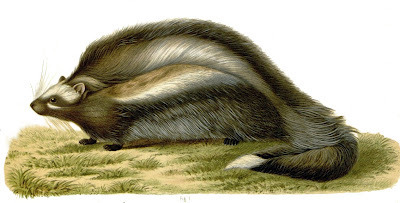 19th-Century colour painting of the type specimen of one of Africa's most amazing rodents - Lophiomys imhausi, the African crested (maned) rat
19th-Century colour painting of the type specimen of one of Africa's most amazing rodents - Lophiomys imhausi, the African crested (maned) ratEveryone thinks that their pet is special, but the following one really was, at least as far as cryptozoology is concerned - because it became the type specimen of a species of rodent hitherto unknown to science but which was so dramatic in form that an entirely new taxonomic family was created in order to accommodate it. And the name of this radical rodent? The African crested rat, also known as the maned rat, whose remarkable nature is not confined to its appearance but also embraces an equally extraordinary talent for interspecific impersonation. Intrigued? Then read on...
Returning home to Europe in 1866 after spending some time on the Mascarene island of Reunion, traveller M. Imhaus stopped off at Aden for a few hours. While there he met a man with a most interesting pet - a large rodent of very distinctive appearance, belonging to a species completely unknown to science. Of stout build with small head and short limbs but long bushy tail, it was principally blackish-brown in colour, but its forehead and the tip of its tail were white, and its flanks each bore a lengthy horizontal strip of pale brown, edged with white and with a white stripe running along its centre. This strip was separated by a type of furrow from the notably long dark hairs borne upon the middle of the animal’s back, and also upon its tail, which were erectile, capable of yielding a very odd-looking mane or crest.
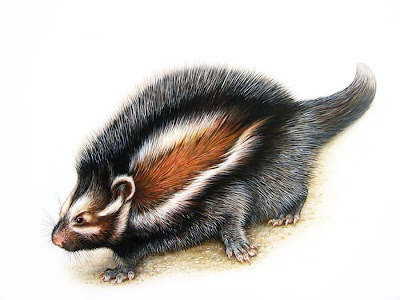 The pelage colouration and pattern of Lophiomys instantly differentiates it from all other rodents (picture source unknown to me)
The pelage colouration and pattern of Lophiomys instantly differentiates it from all other rodents (picture source unknown to me)Imhaus bought the man’s pet, and took it to France’s Garden of Acclimatisation in the Bois de Boulogne, where it thrived for about 18 months upon a diet of maize, vegetables, and bread, and slept during the day. After its death, its body attracted the attention of acclaimed zoologist Prof. Alphonse Milne-Edwards, whose studies of it uncovered sufficient anatomical idiosyncrasies to warrant the creation for its species of a brand new taxonomic family, Lophiomyidae.
In his description of this radically new rodent, published in 1867, Milne-Edwards named it Lophiomys imhausi - ‘Imhaus’s maned rat’. Distributed from Kenya in eastern Africa northwards as far as Ethiopia’s border with Sudan, and measuring up to 21 in long (females are larger than males), its closest relatives appear to be the murids (mice, rats, etc), with which it is nowadays classed by some authorities as a distinct subfamily, Lophiomyinae.
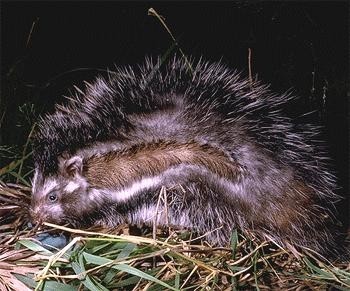 African crested or maned rat — an accomplished skunk impersonator (Kevin Deacon/Wikipedia)
African crested or maned rat — an accomplished skunk impersonator (Kevin Deacon/Wikipedia)A sluggish, generally slow-moving animal, undoubtedly the most distinctive feature of this species is its erectile mane of hair, which has a very important function. The maned rat has few enemies - and little wonder. When challenged by a would-be predator, it raises its mane, and instantly ‘transforms’ into a surprisingly convincing replica of one of the most feared medium-sized mammals of Africa - a long-furred relative of the weasels known as the zorilla or striped polecat Ictonyx striatus.
Although only distantly related to the New World skunks, the zorilla is extraordinarily similar to them, due not only to its vivid black and white fur, but also to its deadly propensity for ejecting streams of unutterably foul-smelling liquid from its anal glands at anything foolish enough to approach it too closely. So dreaded and dreadful is its malodorous arsenal that if a zorilla approaches a lion kill, the lions will back away and wait impatiently but impotently at a safe distance until the little zorilla has eaten its fill and departed. Not for nothing is it referred to by many tribes as ‘Father of the Stenches’!
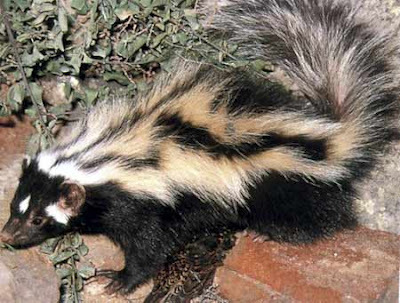 Zorilla — Africa’s ‘Father of the Stenches’ (picture source unknown to me)
Zorilla — Africa’s ‘Father of the Stenches’ (picture source unknown to me)Thus, by impersonating this Dark Continent untouchable, the relatively harmless maned rat (it does have a strong bite) is assured of similar immunity from most would-be assailants. If, however, it does fail to convince, it can actually exude a very toxic glandular secretion that is sufficiently potent to kill a dog if swallowed.
This ShukerNature post is an excerpt from my book Extraordinary Animals Revisited: From Singing Dogs To Serpent Kings (CFZ Press: Bideford, 2007).
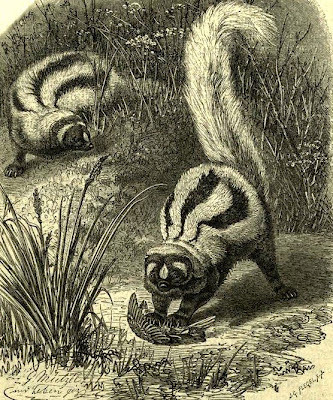 19th-Century engraving depicting a pair of zorillas
19th-Century engraving depicting a pair of zorillas
Published on August 18, 2012 14:17
August 17, 2012
DEMON MASKS, DODOS, WOMBLES, AND OWL KINGS - CAR BOOT SALES AND CRYPTOZOOLOGY #1
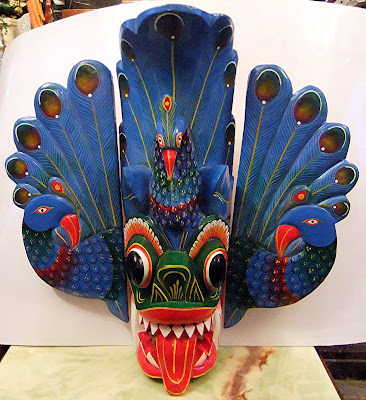 My Sri Lankan peacock demon mask (Dr Karl Shuker)
My Sri Lankan peacock demon mask (Dr Karl Shuker)Those of you who know me personally will be well aware that I am partial to wandering around antique markets and book fairs in search of discoveries pertinent to cryptozoology - but some of my most surprising finds have been unearthed either at the more humble car boot and bric-a-brac sales that are perennially popular throughout the UK or in charity shops, whose contents are wonderfully varied and, by their very nature, wholly unique. (For overseas readers who may not be familiar with the term 'car boot sale', all is revealed here .)
Such items are rarely of great (if, indeed, any!) value in a strictly monetary sense, of course, but in terms of their curio worth, they are, at least in my humble opinion, well worth seeking out and salvaging.
So here, for your delectation and delight, is the first in an occasional series of ShukerNature posts revealing some of the exotica and esoterica that I have uncovered over the years while browsing and bartering at car boot and bric-a-brac sales in search of treasures among the tat.
SRI LANKAN PEACOCK DEMON MASK
I saw this beautiful Sri Lankan wood-carved mask at a car boot sale in Birmingham one chilly morning in January 2012, and recognised what it was straight away. Unfortunately, however, it was being perused at the time by a guy in front of me, who couldn't make up his mind whether he wanted it or not, and was haggling with the stall holder concerning its price – while I was standing just behind him silently but very earnestly willing him to put it down and walk off! Happily, he finally did so, telling the stall holder that he'd have a brief walk round to think about it – but the moment he turned away, I grabbed it, paid for it, and walked triumphantly off with it – result!! He who hesitates, etc etc!
 Two views of my peacock demon mask from Sri Lanka, via Birmingham! (Dr Karl Shuker)
Two views of my peacock demon mask from Sri Lanka, via Birmingham! (Dr Karl Shuker)The mask depicts Maura Raksha, Sri Lanka's peacock demon, who brings peace, harmony, and prosperity, and is one of several demons whose masks are used in various types of traditional dance-based rituals (e.g. devil dancing, kolam dancing, sokari dancing). These masks are also widely seen at the main entrance of Sinhalese homes, to ward off evil influences and protect the householders, and they date back to pre-Buddhist times when Sri Lanka was an agricultural society.
Coincidentally, the previous year I came upon a set of much smaller but no less interesting Oriental demon masks at a different car boot sale. Originating from Thailand this time, they were in the form of ornamental bottle-top covers.
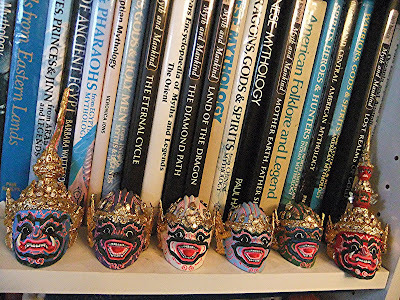 My set of Thai demon mask bottle-top covers – no home should without one! (Dr Karl Shuker)
My set of Thai demon mask bottle-top covers – no home should without one! (Dr Karl Shuker)WAYNE'S WOMBLE
Earlier this year, I spotted a large-sized fluffy toy in the form of a womble on the stall of a friend, Wayne, at a local bric-a-brac market. Wayne had recently obtained it in a batch of items purchased in a house-clearance sale for reselling purposes, and although it had clearly been a much-loved womble in its time, it had evidently seen better days too, as its fur was somewhat bedraggled now. Consequently, I reluctantly declined the opportunity to add it to the Shuker menagerie. Nevertheless, Wayne kindly agreed to snap a photograph of me holding this womble (I think he's Orinoco), because, after all, in the weirdly wonderful world of cryptozoology, you don't know when such a picture may come in useful...well, you don't!
 Underground, overground, wombling free... (Dr Karl Shuker)
Underground, overground, wombling free... (Dr Karl Shuker)ENCOUNTERING THE OWL KING
One of my more recent car boot purchases, this small but delightful figurine is of an owl wearing a crown. I have no idea as to its origin or specific significance, though I am aware that owl kings and similar characters feature in various European folktales, so I assume that this is what it represents.
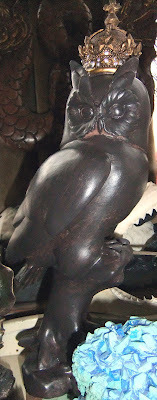 My owl king figurine (Dr Karl Shuker)
My owl king figurine (Dr Karl Shuker)In any event, an owl king purchased for the princely sum of only £5 is certainly a bargain!
And don't forget to check out future ShukerNature posts for more car boot curios! After all, where else are you likely to find a Portuguese egg-bowl in the shape of a dodo??
Happy hunting!
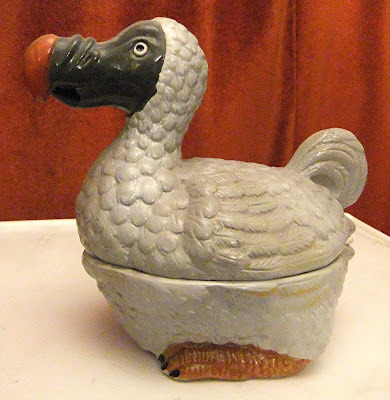 My dodo-shaped Portuguese egg-bowl, purchased at a bric-a-brac market for £2.50 many years ago (Dr Karl Shuker)
My dodo-shaped Portuguese egg-bowl, purchased at a bric-a-brac market for £2.50 many years ago (Dr Karl Shuker)
Published on August 17, 2012 14:20
August 15, 2012
THE TRUTH ABOUT BLACK PUMAS - SEPARATING FACT FROM FICTION REGARDING MELANISTIC COUGARS
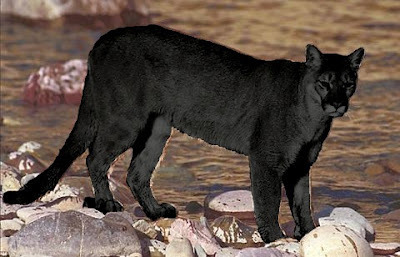 Computer-generated mock-up of a black puma (Dr Karl Shuker)
Computer-generated mock-up of a black puma (Dr Karl Shuker)In all the time that I have been researching and documenting creatures of cryptozoology (almost 30 years now!), I have encountered few subjects engendering more controversy and confusion than the reality, or otherwise, of black pumas. Consequently, I have explored various aspects of this most contentious mystery cat in a number of different publications of mine. Yet as the subject still incites heated debate even today, I feel that it is now time to assemble together my disparate writings concerning it, and present them here (together with some previously-unpublished information) as a ShukerNature review article.
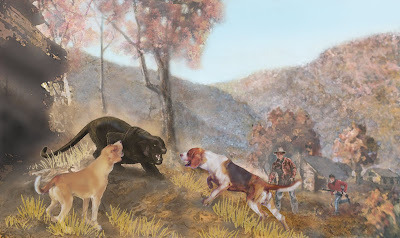 North American mystery black panther – a melanistic leopard, or a black puma? (William Rebsamen)
North American mystery black panther – a melanistic leopard, or a black puma? (William Rebsamen)The two most commonly-voiced identities for Britain’s elusive ebony-furred mystery cats, as well as those reported in continental Europe, North America, and Australia, are escapee/released black panthers (i.e. melanistic, all-black specimens of the leopard Panthera pardus) and black (melanistic) pumas. Yet whereas the former is plausible, the latter is little short of impossible - for two extremely good, fundamental reasons.
REASON #1: CONSPICUOUS BY ITS ABSENCE
Ordinarily, the puma Puma concolor (aka the cougar, mountain lion, panther, catamount, and painter) occurs in two separate colour forms (morphs) – tawny-red, and slaty-grey, both of which are common.
 A normal tawny-coloured puma
A normal tawny-coloured pumaConversely, even though this species has the greatest native distribution range of any modern-day wild cat, occurring from the northernmost regions of North America to the southern tip of South America, the number of confirmed black pumas can be counted on the claws of one paw!
Not a single scientifically-confirmed preserved specimen exists. In 1843, a bona fide black puma was shot in the Carandahy River section of Brazil by professional hunter William Thomson, but regrettably its skin was not retained. In addition, I have seen various online mentions of an enigmatic taxiderm cat dubbed the 'Cherokee cougar' that has been claimed to be a black puma. Measuring 6 ft 2 in (1.87 m) long, and variously said to have been shot in Tennessee or Montana, it has been denounced by sceptics as a normal puma that has been dyed black, or some entirely different feline species. However, hair samples from it that were tested by researchers from the zoology department of East Tennessee State University confirmed that they had not been dyed, and DNA samples verified that it was a puma. Nevertheless, photos of it (not seen by me so far) apparently suggest that it is dark brown rather than truly black.
Unfortunately, however, no primary sources concerning this potentially significant specimen are provided by any online documentation that I have encountered so far. So if any reader can provide some, or can offer any further information or first-hand observations regarding it, I would greatly welcome receipt of them.
In 1998, American mystery cat investigator Keith Foster of Holcolm, Kansas, informed me that what had been reported to him by the person concerned as being a "glossy black puma" had been shot and killed in Oklahoma several years previously after it had been killing sheep on his father's farm. Afterwards, this person (a church pastor who was known to Keith) contacted the authorities, and the Oklahoma Department of Wildlife duly confiscated the cat's carcase. Nothing more was heard about it after that, but Keith vowed to trace it. Unlike so many cryptozoological cases featuring a missing specimen, moreover, Keith did succeed in doing so, but was disappointed to discover that it wasn't glossy black in colour after all, merely grey.
As for pictorial evidence, only one clear, unequivocal photograph of a black puma is known. Reproduced below, this photo depicts a dead specimen shot in 1959 by Miguel Ruiz Herrero in the province of Guanacaste along Costa Rica's north Pacific coast. Estimated to weigh 100-120 lb, its carcase is seen here alongside Ruiz's herdsman, but what happened to it afterwards is unknown.
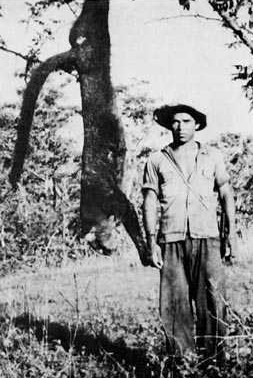 Ruiz's black puma (Miguel Ruiz Herrero)
Ruiz's black puma (Miguel Ruiz Herrero)In view of such exceptional scarcity of tangible evidence, it is evident that the prospect of any of Britain's, Europe's, or Australia's black mystery cats being escapee/released black pumas is unlikely in the extreme. After all, if there were such extraordinarily rare non-native cats as black pumas in captivity in any of these regions, they would surely have attracted immense publicity, and would have been far too valuable to be allowed to escape or to be released by their owners.
But what about in North America, where the puma is a native species? Surely a black morph could have arisen here? After all, countless sightings of seemingly very large all-black cats claimed by their eyewitnesses to be melanistic pumas have been reported all over this continent (most especially in the east), and continue to be today. There are even Native American traditions appertaining to such beasts, which they termed 'black devils' or 'devil cats'. But could they truly be melanistic pumas? Not according to Reason 2.
REASON #2: THE TWO-TONE DILEMMA
Whereas most melanistic cat forms are uniformly black all over, so-called black pumas only have black upperparts. Their underparts are noticeably paler, usually slate-grey or dirty cream. This provides crucial evidence for discounting such cats as the identity of Britain’s, Europe's, North America's, and Australia's pantheresque mystery cats, because these latter felids, just like bona fide black panthers (and also like melanistic specimens of the jaguar Panthera onca), are black all over.
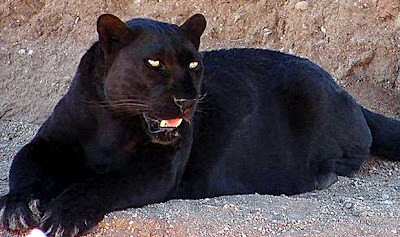 A black panther, i.e. melanistic leopard (Qilinmon at the English language Wikipedia)
A black panther, i.e. melanistic leopard (Qilinmon at the English language Wikipedia)The black puma's distinctive two-tone colouration, black dorsally and paler ventrally, can be clearly discerned in Ruiz's specimen. Equally, the Carandahy River specimen's appearance was described by Thomson in his book Great Cats I Have Known (1896) as follows:
"The whole head, back, and sides, and even the tail, were glossy black, while the throat, belly, and inner surfaces of the legs, were shaded off to a stone gray."
THE JAGUARETE – AN AMALGAMATED ANOMALY?
Yet although exceedingly scarce today, black pumas do seem to have been more common in past ages, certainly in South (even if not in North) America, because there are a number of reports and even one or two early illustrations of such cats, sometimes dubbed ‘couguars noires’, in archaic natural history tomes. And these reports and illustrations often compare closely with the (very) few verified modern-day specimens - although in some cases there appears to have been confusion between, and amalgamation of, reports of black pumas and reports of black jaguars.
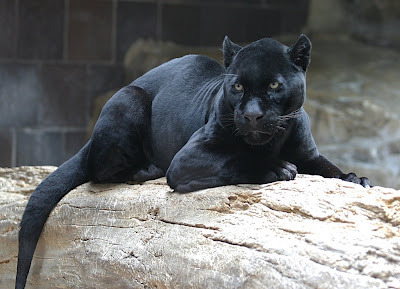 A black (melanistic) jaguar (cburnett/Wikipedia)
A black (melanistic) jaguar (cburnett/Wikipedia)I examined this confusing situation as follows in my very first book, Mystery Cats of the World (1989):
"Referred to in Latin America as `black tigers', [melanistic jaguars] tend to be noticeably large, especially in the Mato Grosso. According to various antiquarian zoology tomes and native Guyanan beliefs however, a further type of black tiger would seem to exist within this continent, one which allegedly is very different morphologically from the typical melanistic jaguar. Nevertheless, its precise identity has never been satisfactorily ascertained.
"Nowadays a totally forgotten felid, this mysterious melanistic was referred to as the `cougar noire' by the eminent eighteenth-century naturalist de Buffon, and as the `jaguarete' (a less ambiguous name, which I therefore prefer and shall use hereafter in this book) by his equally eminent contemporary Thomas Pennant. However, in the virtually verbatim version of Pennant's description which appeared in Thomas Bewick's A General History of Quadrupeds, S. Hodgson referred to it merely as `the black tiger'. Hodgson's choice of name would seem to imply that the jaguarete is truly nothing more than a straightforward melanistic jaguar. Yet neither the illustration which accompanied Pennant's description nor that (by Bewick) which accompanied Hodgson's is compatible with such an identity. To quote Pennant:
"'Head, back, sides, fore part of the legs, and the tail, covered with short and very glossy hairs, of a dusky-color; sometimes spotted with black, but generally plain: upper lips white: at the corner of the mouth a black spot: long hairs above each eye, and long whiskers on the upper lip; lower lip, throat, belly, and the inside of the legs, whitish, or very pale ash-color; paws white: ears pointed. Grows to the size of a heifer of a year old: has vast strength in its limbs. Inhabits Brasil and Guiana (Guyana]: is a cruel and fierce beast; much dreaded by the Indians; but happily is a scarce species.'"
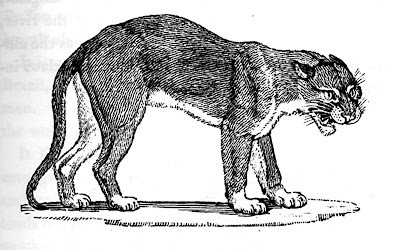 Bewick's 'black tiger', in which it is clearly two-tone (like a black puma) rather than uniformly black (like a black jaguar)
Bewick's 'black tiger', in which it is clearly two-tone (like a black puma) rather than uniformly black (like a black jaguar)"In addition, Hodgson noted that it frequented the seashore and that it preyed upon a variety of creatures (including lizards, alligators and fishes) as well as devouring turtles' eggs and (rather curiously) the buds and leaves of the Indian fig."
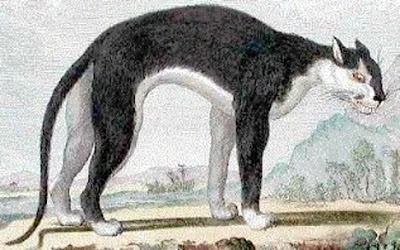 Buffon's two-tone 'cougar noire'
Buffon's two-tone 'cougar noire'Subsequent to writing Mystery Cats of the World , I discovered that in 1778, German naturalist Johann Christian Daniel Schreber had formally described the jaguarete and christened it Felis discolor ('two-coloured cat'). Yet, paradoxically, the accompanying colour illustration of it merely showed a mid-/dark-brown cat resembling a normal puma!
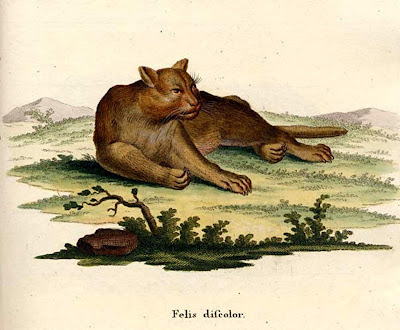 Schreber's monotone 'two-coloured cat'
Felis discolor
Schreber's monotone 'two-coloured cat'
Felis discolorReturning to my book's account of this mysterious cat:
"What could the jaguarete be? On first sight, a black jaguar identity seems most likely - in most specimens, the rosettes can indeed be seen as cryptic markings against the coat's abnormally dark colouration. However, the black jaguar is dark dorsallv and ventrally, just like the black panther and other melanistic felid individuals, thereby contrasting markedly with the near-white underparts, lowers jaw and paws of the jaguarete. Of course, it may be that the jaguarete is nothing more than an inaccurate description of a black jaguar, but arguing against this is the statement in a footnote by Pennant that two jaguaretes were actually shown in London during the eighteenth century; hence their appearance would have been familiar to naturalists of that time."
In my book, I went on to consider two additional jaguar possibilities. One was that the jaguarete was a jaguar possessing the rare recessive black-and-tan mutant allele of the agouti gene in homozygous (two-copy) form, because this yields a cat with black dorsal pelage but light or cream underparts, which corresponds well with the shot black pumas of Thomas and Ruiz. The other possibility was a pseudo-melanistic jaguar, i.e. one in which its rosettes had freakishly multiplied and amalgamated to yield a similar appearance – black dorsally and normal, paler colouration ventrally.
However, having given the matter of the jaguarete further consideration since writing that book, I now deem it more plausible that like so many other cryptids (such as the great sea serpent and the Nandi bear), the jaguarete was in reality a non-existent composite beast, erroneously created by combining together reports of wholly different animals. In the case of the jaguarete, those animals would seem to be normal South American melanistic jaguars (explaining the spots) and rare but nevertheless real South American melanistic pumas (explaining the two-tone colour scheme, which matches that of the Ruiz and Thomas cats). Certainly, some of the images that I have seen of the jaguarete greatly resemble black pumas of this nature, even including the puma's characteristic black facial bar, as seen, for instance, in the illustration below:
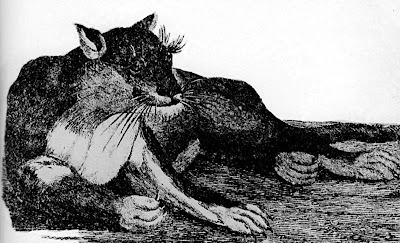 Engraving of the jaguarete in Thomas Pennant's A History of the Quadrupeds (1781)
Engraving of the jaguarete in Thomas Pennant's A History of the Quadrupeds (1781)THE YANA PUMA – NEITHER PUMA NOR JAGUAR?
As if the jaguarete had not muddied – and muddled - the taxonomic waters sufficiently in relation to black pumas and black jaguars, South America may also be home to a further melanistic mystery cat, and of quite prodigious size, as documented by me in another of my books, The Beasts That Hide From Man (2003). Known as the yana puma, it may even have been the inspiration for one of Sir Arthur Conan Doyle's most famous short stories, 'The Brazilian Cat', which was first published by Strand Magazine in 1898, then republished in a 1923 collection of his horror stories, Tales of Terror and Mystery.
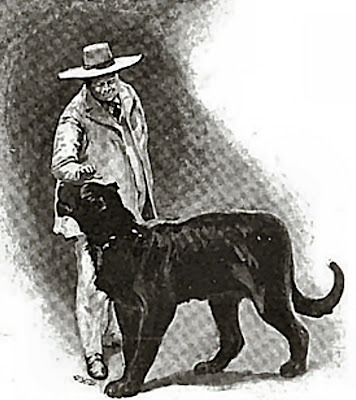 One of the illustrations by Sidney Paget accompanying the original 1898 publication of 'The Brazilian Cat'
One of the illustrations by Sidney Paget accompanying the original 1898 publication of 'The Brazilian Cat'Here is a condensed version of my book's account of the yana puma:
"Several years ago, I read a short story by Conan Doyle called 'The Brazilian Cat', published in 1923, which featured a huge, ferocious, ebony-furred felid that had been captured at the headwaters of the Rio Negro in Brazil. According to the story: "Some people call it a black puma, but really it is not a puma at all". Yet there was no mention of cryptic rosettes, which a melanistic (all-black) jaguar ought to possess, and it was almost 11 ft in total length - thereby eliminating both puma and jaguar from consideration anyway. Hence I simply assumed that Doyle's feline enigma was fictitious, invented exclusively for his story - but following some later cryptozoological investigations of mine, I am no longer quite so sure.
"To begin with: in Exploration Fawcett (1953), the famous lost explorer Lt.-Col. Percy Fawcett briefly referred to a savage 'black panther' inhabiting the borderland between Brazil and Bolivia that terrified the local Indians, and it is known that Fawcett and Conan Doyle met one another in London. So perhaps Fawcett spoke about this 'black panther' and inspired Doyle to write his story. But even if so, it still does not unveil the identity of Fawcett's panther. Black pumas are notoriously rare - only a handful of specimens have been obtained from South and Central America (and none ever confirmed from North America). Conversely, black jaguars are much more common, and with their cryptic rosettes they are certainly reminiscent of (albeit less streamlined than) genuine black panthers, i.e. melanistic leopards. However, the mystery of Brazil's black panthers is far more abstruse than this... [I then went on to discuss the Brazilian jaguarete, referring to the accounts of Buffon and Pennant already incorporated in this present ShukerNature article.]
"Yet as it seemed to be nothing more than a non-existent composite creature - 'created' by early European naturalists unfortunately confusing reports of black jaguars with black pumas - the jaguarete eventually vanished from the wildlife books. Even so, its rejection by zoologists as a valid, distinct felid may be somewhat premature. This is because some reports claimed that the jaguarete was much larger than either the jaguar or the puma - a claim lending weight to the prospect that a third, far more mysterious black cat may also have played a part in this much-muddled felid's history.
"Dr Peter J. Hocking is a zoologist based at the Natural History Museum of the National Higher University of San Marcos, in Lima, Peru. Aside from his official work, for several years he has been collecting and investigating local Indian reports describing various different types of mysterious, unidentified cat said to inhabit the Peruvian cloudforests. One of these, of great relevance here, has been dubbed by him 'the giant black panther'.
"In an article published by the journal Cryptozoology in 1992, Dr Hocking revealed that this particular Peruvian mystery cat is said to be entirely black, lacking any form of cryptic markings, has large green eyes, and is at least twice as big as the jaguar. Moreover, the Quechua Indians term it the yana puma ('black mountain lion'). This account immediately recalls Conan Doyle's story of the immense Brazilian black cat. The yana puma is apparently confined to montane forest ranges only rarely visited by humans, at altitudes of around 1600-5000 ft. If met during the day, when resting, it is generally passive, but at night this mighty cat becomes an active, determined hunter that will track humans to their camps and has sometimes slaughtered an entire party while they slept, by lethally biting their heads.
"When discussing the yana puma with mammalogists, Hocking has frequently been informed that it is probably nothing more than a large melanistic jaguar. Yet as he pointed out in his article, such animals do not attain the size claimed for this mysterious felid (nor do melanistic pumas) - and the Indians are adamant that it really is quite enormous. Nevertheless, the yana puma could still merely be a product of native exaggeration, inspired by real black jaguars (or pumas) but distorted by superstition and fear.
"However, a uniformly black, unpatterned felid does not match either a black jaguar or a black puma - yet it does compare well with Conan Doyle's Brazilian cat. Moreover, as some jaguarete accounts spoke of a black cat that was notably larger than normal jaguars and pumas, perhaps the yana puma is not limited to Peru, but also occurs in Brazil. Is it conceivable, therefore, that Doyle (via Fawcett or some other explorer contact) had learnt of the yana puma, and had based his story upon it? If so, it would be one of the few cases on file in which a bona fide mystery beast had entered the annals of modern-day fiction before it had even become known to the cryptozoological - let alone the zoological - community!"
Particularly intriguing in relation to the yana puma is an illustration that I recently came upon while browsing through Sir William Jardine's tome The Natural History of the Felinae (1834). It was a magnificent watercolour drawing by James Hope Stewart of an alleged black puma from Paraguay, dubbed ‘Felis nigra’, with big green eyes and unpatterned coat.
 ‘Felis nigra’, a black puma – or even the yana puma?
‘Felis nigra’, a black puma – or even the yana puma?Yet unlike other abnormally dark pumas on record, the Jardine individual was black all over, rather than being black dorsally and paler ventrally. Consequently, its uniformly black, unpatterned pelage, together with its large green eyes, accord well with native descriptions of the Peruvian yana puma.
ARE BLACK PUMAS AN OPTICAL ILLUSION?
Over the years, a number of explanations for claimed sightings of native black pumas in North America and escapee/released non-native black pumas elsewhere have been put forward, proposing that they are merely normal pumas observed under abnormal conditions. When tested, however, such theories have failed to deliver. To quote once again from my Mystery Cats of the World :
"[As contemplated by veteran puma investigator Bruce Wright:] Could normal-coloured pumas appear black when wet? To investigate this, Wright took the fresh hide of a newly killed puma from Vancouver Island, suspended it by its edges, filled it with water and left it overnight. When he examined it the following morning, however, despite viewing and photographing it from every conceivable angle, he was unable to make it appear black in colour. He also considered the possibility that backlighting of normal pumas could create the illusion of black fur, but this, when checked, proved untenable too."
A BLACK PUMA AT LONDON ZOO?
Finally: The following account and images, included here as a ShukerNature exclusive, are excerpted from my forthcoming book Cats of Magic, Mythology, and Mystery (CFZ Press: Bideford, 2012). Once this book has been published, I shall remove the watermarks from the images below:
"As far as I was aware, no such animal [black puma] had ever been kept in captivity, at least not in Europe. But all that changed a while ago during one of my numerous visits to one of my all-time favourite places – Hay On Wye, Herefordshire’s world-famous ‘Town of Books’, nestling on the Welsh border.
"In addition to around 30 bookshops at present, this small town also has shops devoted to antiquarian prints. As an avid collector of such items, I was browsing in one of these shops one sunny Saturday afternoon during the late 1990s when I came upon a truly remarkable example – remarkable because it is not often that an antiquarian print depicts a cryptozoological cat!
"The print in question, which was an original hand-coloured copper engraving dating from 1862 (as written in pencil on its reverse), and which I naturally lost no time in purchasing, is duly reproduced here (its previous appearance, in an article of mine published by the now defunct British monthly magazine Beyond, where it was reproduced in its original full-colour format, may well have been the first time that it had ever been published anywhere), and appears to portray a bona fide black puma."
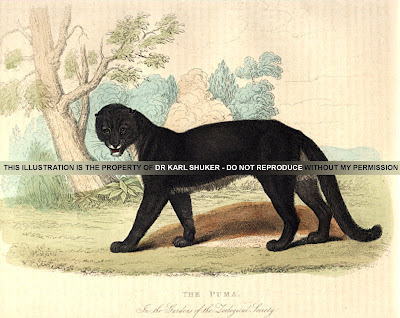 My black puma engraving (Dr Karl Shuker)
My black puma engraving (Dr Karl Shuker)"Certainly, it comes complete with jet-black upperparts, slaty-grey underparts, and white chest – very different from normal pumas, which are either tawny brown-rufous or silver-grey (the puma exhibits two distinct colour morphs), but matching precisely those few confirmed black puma specimens. Most interesting of all, however, is the engraving’s caption: “The Puma. In the Gardens of the Zoological Society”. This means that if the puma in the engraving has been coloured accurately, and there is no reason why it should not have been, a black puma, that most mysterious of mystery cats, was once actually on display at London Zoo!
"When I first discovered this engraving, I wondered whether its astonishing black puma was exhibited at London Zoo at the same time as the zoo’s unique captive woolly cheetah, bearing in mind that the engraving was dated 1862. Who knows, if so, it may even have been in the enclosure next door!
"In February 2011, however, I discovered a second copy of the same puma engraving, but this one was dated 1825. (Moreover, the hand-colouring on this latter version, reproduced here, is much more skilful.)"
 The second version of the black puma engraving (Dr Karl Shuker)
The second version of the black puma engraving (Dr Karl Shuker)"So which (if either) is the correct date for it? The mystery deepens, and darkens – which is very apt for anything featuring a black puma at its core!"
Indeed it is. For as I have shown here, the all-too-commonly-cited 'explanation' in media reports of black mystery cats being black pumas is woefully unsubstantiated at the present time by confirmed evidence of such cats' existence. Or, to rephrase this situation in a more succinct manner – AWOL black pumas RIP!
NB - In most cat species, melanism is due to the expression in homozygous (two-copy) form of a recessive mutant allele; in the leopard and probably other species too, this is the non-agouti mutant allele of the agouti gene. Conversely, in the jaguar and also the jaguarundi Puma yagouaroundi, melanism is due to the expression of a dominant mutant allele instead. In the case of the puma, however, the genetic basis of melanism is presently unknown, but as black pumas do not display a uniformly black pelage anyway but rather a two-tone pelage, it is likely to be due to a fundamentally different genetic scenario.
 Holding a model of a black panther (Dr Karl Shuker)
Holding a model of a black panther (Dr Karl Shuker)
Published on August 15, 2012 18:55
August 9, 2012
THE BONOBO OR PYGMY CHIMPANZEE - A NEW APE, INCOGNITO
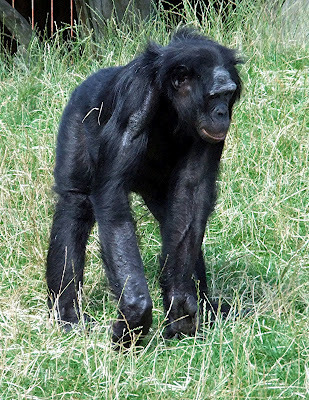 A bonobo at Twycross Zoo (Dr Karl Shuker)
A bonobo at Twycross Zoo (Dr Karl Shuker)One of the highlights of my visit yesterday to Twycross Zoo in Leicestershire, England - famous worldwide for its very comprehensive collection of primates and its excellent record of success in breeding and conserving endangered species - was viewing its breeding group of bonobos or pygmy chimpanzees Pan paniscus, led as is normal for this species by an alpha female (in the common chimp, conversely, it is an alpa male who acts as group leader).
Our own species' closest living relative (putative living Neanderthals excepted!), the bonobo is visibly different in several ways from the much more familiar common chimpanzee P. troglodytes - which makes it all the more remarkable that its separate taxonomic status was not even suspected, let alone recognised, until the 1920s, i.e. less than 100 years ago. The history of the bonobo's official scientific discovery and classification as a valid species of great ape in its own right is a major success story for cryptozoology, and makes fascinating reading, which I have documented in all three of my books on new and rediscovered animals - The Lost Ark( 1993), The New Zoo (2002), and The Encyclopaedia of New and Rediscovered Animals(2012), and is now reproduced here on ShukerNature:
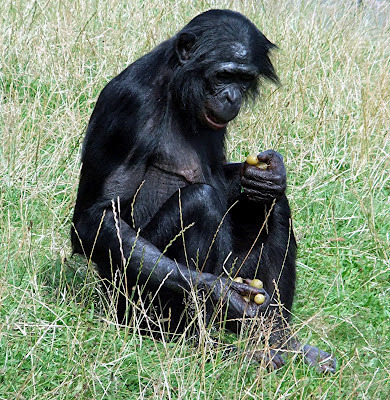 The bonobo is visibly different from - and much more human-like than - the common chimpanzee (Dr Karl Shuker)
The bonobo is visibly different from - and much more human-like than - the common chimpanzee (Dr Karl Shuker)Until the mid-1920s, science only accepted the existence of one species of chimpanzee, the familiar common species Pan troglodytes, generally divided into three subspecies. In 1928, however, zoologist Dr Ernst Schwarz was examining some specimens at the Congo Museum in Tervueren, Belgium, when he came upon a series of skeletons and skins of a chimpanzee type that appeared very different from any that he had seen before.
 Two bonobos at Twycross Zoo (Dr Karl Shuker)
Two bonobos at Twycross Zoo (Dr Karl Shuker)Obtained by a M. Ghesquiere, they revealed that this strange form of chimpanzee was smaller in size than the common species, and was much more slender in build. Its head was smaller too, but its face was longer and narrower, its dense fur was also long and was uniformly black except for a small white patch on the rump, and it lacked the common chimpanzee's familiar white beard. Schwarz discovered that these odd-looking chimps had been collected in an area of tropical rainforest on the south bank of the Congo River - all previously recorded chimpanzees had been obtained from localities north of this river.
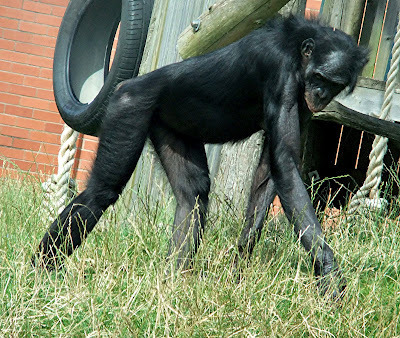 Until viewing Twycross's specimens yesterday, I had not realised just how gracile, or relatively long-limbed, the bonobo is in comparison with the common chimpanzee (Dr Karl Shuker)
Until viewing Twycross's specimens yesterday, I had not realised just how gracile, or relatively long-limbed, the bonobo is in comparison with the common chimpanzee (Dr Karl Shuker)Evidently, the southern chimps comprised an important find, and their distinctive morphology persuaded Schwarz that they represented a currently undescribed subspecies. Hence in 1929 he formally documented it within the museum's journal, naming this new ape P. t. paniscus - the pygmy chimpanzee. Five years later, it was elevated to the level of a full species - P. paniscus.
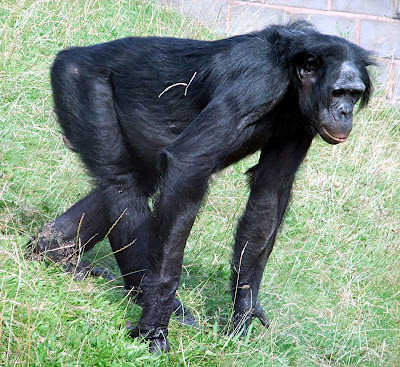 Bonobo - the leggiest member of the great apes (Dr Karl Shuker)
Bonobo - the leggiest member of the great apes (Dr Karl Shuker)Once science became aware of this freshly-found primate, investigations uncovered that the Tervueren examples were not the only specimens of pygmy chimp to have been collected without recognition of their separate taxonomic status. The British Museum's collections had contained one in 1895, for instance, and a living example of what was almost certainly a pygmy chimp had been on show for a time in 1923 at New York's Bronx Zoo. Similarly, John Edwards, a zoological historian and Fellow of London's Zoological Society, has kindly brought to my attention a picture postcard in his private collection depicting a chimp housed in Amsterdam Zoo, again during the early 1920s, which was quite obviously a pygmy chimpanzee.
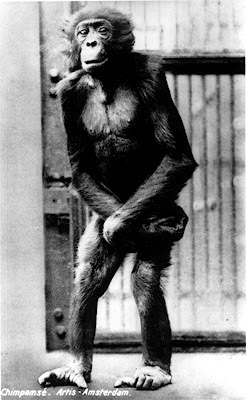 John Edwards's historically significant postcard, depicting a bonobo maintained at Amsterdam Zoo before the separate taxonomic status of its species had been recognised (John Edwards)
John Edwards's historically significant postcard, depicting a bonobo maintained at Amsterdam Zoo before the separate taxonomic status of its species had been recognised (John Edwards)Since the species' 'official' discovery, specimens (correctly identified) have been exhibited at several zoological gardens, particularly in European collections such as Antwerp Zoo and Vincennes Zoo. In 1962, Frankfurt Zoo succeeded in breeding pygmy chimps for the first time in captivity, and has repeated this feat on a number of occasions since then. Studies of captive individuals such as these have revealed that the pygmy chimpanzee is much more docile and even-tempered than its less placid, better-known relative.
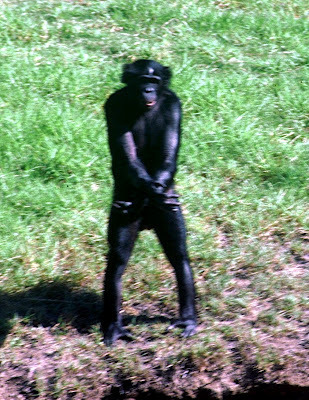 Bonobos are able to stand upright on their hind legs and are adept at walking bipedally too (Alan Pringle)
Bonobos are able to stand upright on their hind legs and are adept at walking bipedally too (Alan Pringle)There has been a fair amount of controversy concerning the pygmy chimpanzee's precise taxonomic identity. Whereas some experts are so convinced of its distinct specific status that they have even placed it within its own genus, as Bonobo paniscus (bonobo is its native name), certain others still prefer to treat it merely as a subspecies of the common chimpanzee. Recent biochemical and genetic comparisons between common and pygmy chimps, however, indicate that the latter ape is certainly sufficiently distinct to justify classification as a separate species (though whether separate generic status for it is warranted is still a matter for conjecture).
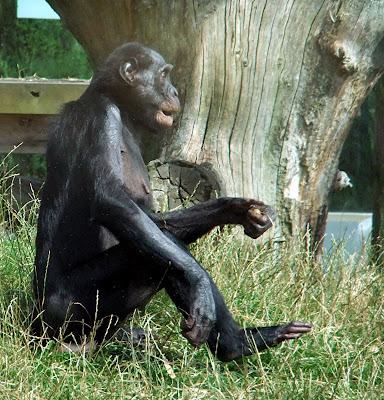 When viewing a photograph like this one, it is not difficult to comprehend that the bonobo is our own species' closest living relative (Dr Karl Shuker)
When viewing a photograph like this one, it is not difficult to comprehend that the bonobo is our own species' closest living relative (Dr Karl Shuker)It seems surprising that a wholly new species of ape could remain undetected by science until as recently as the late 1920s, especially when specimens were actually preserved in scientific museums and exhibited alive in zoos. In fact, there is an even more ironic twist to this tale. Following extensive researches on the subject, Vernon Reynolds revealed in the 1960s that the individual designated by Linnaeus way back in 1758 as his type specimen for the common chimpanzee was actually a pygmy chimpanzee!
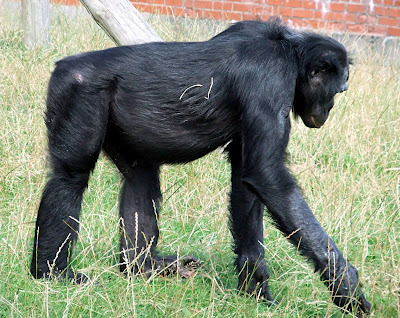 The bonobo - now recognised as a wholly discrete, second species of chimpanzee after centuries of taxonomic obscurity (Dr Karl Shuker)
The bonobo - now recognised as a wholly discrete, second species of chimpanzee after centuries of taxonomic obscurity (Dr Karl Shuker)For many more remarkable histories of animal discovery and rediscovery, please check out my latest book, The Encyclopaedia of New and Rediscovered Animals: From Okapis to Onzas - and Beyond (Coachwhip Publications: Landisville, 2012).
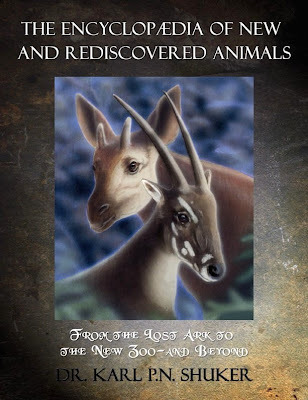
Published on August 09, 2012 16:18
August 8, 2012
SEX AND THE SINGLE SATYR
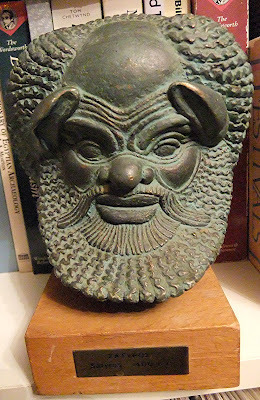 Replica of Greek satyr bust from c.400 BC (Dr Karl Shuker)
Replica of Greek satyr bust from c.400 BC (Dr Karl Shuker)A few months ago, I spotted in a charity shop the very unusual artefact depicted above at the beginning of this ShukerNature blog post; and after recognising what it was, I lost no time in purchasing it for the princely sum of just £5. It is a replica of a Greek stone bust dating from c.400 BC, which portrays the head of a satyr.
 Typical latter-day depiction of satyr as goat-man in a medieval bestiary by Aldrovandi
Typical latter-day depiction of satyr as goat-man in a medieval bestiary by AldrovandiToday, the popular image of a satyr is that of a semi-human semi-goat entity, with hairy goat-legs and hoofed feet, a pair of short curly horns, and a very inconspicuous goat-tail.
 'Satyr Among Roses' (Jade Bengko)
'Satyr Among Roses' (Jade Bengko)In classical Greek mythology, conversely, the satyr was originally represented with the long, profusely-haired tail of a horse, with pointed donkey-like ears rather than horns, a flattened nose, and the legs and feet of a normal human.
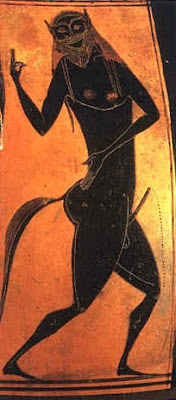 Satyr depicted with a long, full-bodied horse-tail on a pottery fragment from a Greek amphora dating from the 6th Century BC
Satyr depicted with a long, full-bodied horse-tail on a pottery fragment from a Greek amphora dating from the 6th Century BCLovers of wine, nymphs, and playing music with their panpipes, satyrs were disciples of a minor demi-god of fertility called Silenus, and, just like him, they were also enthusiastic followers of Dionysus, the Greek god of wine. As Silenus was commonly portrayed as an elderly man of typically inebriated aspect, old satyrs were duly referred to as sileni (young ones were known as satyrisci).
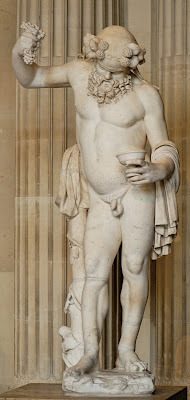 'Drunken Silenus', a 2nd-Century-AD Roman marble statue in the Louvre, Paris (public domain)
'Drunken Silenus', a 2nd-Century-AD Roman marble statue in the Louvre, Paris (public domain)During Roman times, however, the image of the satyr became conflated and ultimately synonymised with that of a rustic Roman nature deity called Faunus. He was half-human, half-goat, as were his followers, known as fauns (though originally they were described as half-human, half-deer).
 Statue of Faunus at the Fountain of Neptune in Florence, Italy, sculpted by Bartolomeo Ammanati (public domain)
Statue of Faunus at the Fountain of Neptune in Florence, Italy, sculpted by Bartolomeo Ammanati (public domain)Since then, satyrs and fauns have generally been treated as one and the same type of mythical entity. But just how mythical – or otherwise – are satyrs?
As described time and again in mythology and folklore, satyrs were infamously lewd and lustful, never happier than when, fuelled by copious quantities of wine, they were in lecherous pursuit of some hapless nymph to ravish.
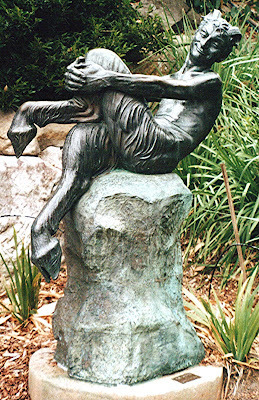 Satyr statue by Frank (Guy) Lynch in Sydney Botanic Gardens, Australia, visited by me during autumn 2006 (Dr Karl Shuker)
Satyr statue by Frank (Guy) Lynch in Sydney Botanic Gardens, Australia, visited by me during autumn 2006 (Dr Karl Shuker)In my book The Unexplained (1995), I documented a remarkable cryptozoologically-relevant link between these priapic satyrs of classical legend and certain forms of elusive man-beast being reported today – with the emphasis very definitely upon priapic. Here is what I wrote:
"In Greek mythology, satyrs were semi-humans with the hairy legs, hooves, tail, and short horns of goats - but did they have a basis in reality? This unexpected prospect was raised in a stimulating paper published in the scientific journal Human Evolution in 1994 by Dr Helmut Loofs-Wissowa from the Australian National University's Faculty of Asian Studies.
"In ancient classical art, satyrs were frequently portrayed with a prominently erect penis - even when engaging in non-sexual activity. Indeed, it was this characteristic that earned them their reputation for sexual licentiousness. However, Dr Loofs-Wissowa believes that this is all fallacious - that in reality, the satyrs were displaying a physiological condition known as the penis rectus, in which the penis assumes a horizontal position even when flaccid. Among modern humans, this condition is only recorded from the bushmen of South Africa, but it is often portrayed in prehistoric cave art, including some Upper Palaeolithic examples from Europe, in which the figures exhibiting the penis rectus condition are hairy humanoids."
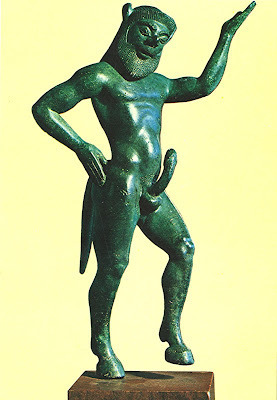 Classical Greek satyr statue ostensibly portraying the penis rectus condition (Athens Archaeological Museum)
Classical Greek satyr statue ostensibly portraying the penis rectus condition (Athens Archaeological Museum)"There are two very intriguing aspects concerning this. One is that anthropologists have argued that these hirsute figures are representations of Neanderthal Man Homo neanderthalensis, which is believed to have died out at least 30,000 years ago. The other is that sightings of hairy troll-like humanoids are often reported in many parts of Asia, and these are believed by some scientists to be relict, modern-day Neanderthals, eluding formal scientific discovery. Of particular note here is that eyewitness descriptions of these mystifying entities have often alluded to the odd fact that they seem to have permanently erect penises, apparent even when spied indulging in non-sexual activity such as eating or walking. This suggests that they are in reality displaying the penis rectus condition.
"Combining all of this information, Loofs-Wissowa suggests that the penis rectus condition is clearly a marker in human palaeontology, i.e. indicating the identity of Neanderthals. And, as a direct consequence, he boldly proposes that satyrs might actually have been latter-day Neanderthals. He notes that many features attributed to satyrs in artistic representations differentiate them from modern humans but ally them to Neanderthals. These include their hairy body, upturned nose, prominent eye ridges, round head, strong neck - and, most noticeable of all, their exhibition of the penis rectus condition, hitherto wrongly identified as an overtly visual indication that satyrs possessed a hyperactive sex drive.
"A very novel idea, but it still leaves unexplained the small matter of the satyrs' hooves and tail, not to mention their horns..."
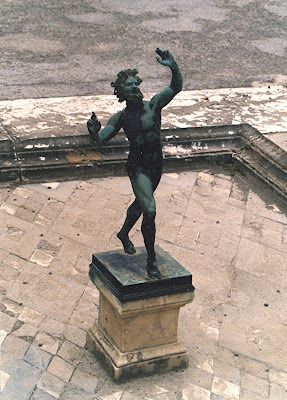 Statue of a satyr unearthed at Pompeii, Italy (Dr Karl Shuker)
Statue of a satyr unearthed at Pompeii, Italy (Dr Karl Shuker)Not all cryptozoologists, however, agree that satyrs may represent relict Neanderthals. In their book The Field Guide to Bigfoot, Yeti, and Other Mystery Primates Worldwide (Avon Books: New York, 1999), Loren Coleman and Patrick Huyghe propose an alternative but equally thought-provoking option. They suggest that man-beasts exhibiting this distinctive penile condition represent a category of man-beast entirely separate from Neanderthals. They term it the Erectus Hominid, as they believe this man-beast may constitute a surviving representative of one of our own species' ancestors, Homo erectus:
"The Erectus Hominid is probably the least known of the world's mystery hominids. The reason for this is simple: most of the beings in this class have in the past been misidentified as Neanderthal. The Erectus Hominid is human-sized to about six feet tall. Its body is also within the standard human range with a slight barrelling of the chest. They are partially to fully hairy, with head hair longer than their body hair. The males of the class normally display a semi-erect penis."
Whatever the identity of satyrs in European mythology may be, however, there is an intriguing yet generally overlooked reason for their unbridled libido and debauched passion for seducing nymphs – the same reason why I entitled this ShukerNature blog post 'Sex and the Single Satyr'. Remarkably, there is no reference anywhere in the annals of classical mythology to female satyrs!
 'Nymphs and Satyr', painted by William-Adolphe Bouguereau (1825-1905)
'Nymphs and Satyr', painted by William-Adolphe Bouguereau (1825-1905)By definition, therefore, all satyrs were doomed to remain single, celibate, and sexually frustrated – unless they could achieve some lascivious success with the local dryads (wood nymphs) and oreads (mountain nymphs). Equally, such illicit liaisons offered the only opportunity for satyrs to procreate, producing new generations of satyrs, albeit ones that were increasingly diluted by the nymphs' genetic input.
 Statue of an infant faun at Glastonbury, Somerset (Dr Karl Shuker)
Statue of an infant faun at Glastonbury, Somerset (Dr Karl Shuker)Eventually, satyrs simply vanished from folklore and traditions, but, faced with such an uncertain, unpredictable pathway to reproductive success, it is hardly surprising really that they became extinct!
 Satyr frolicking with nymphs, painted by Claude Lorrain (public domain)
Satyr frolicking with nymphs, painted by Claude Lorrain (public domain)
Published on August 08, 2012 18:33
August 5, 2012
RIDDLE OF THE BURU, AND THE LUNGFISH LINK
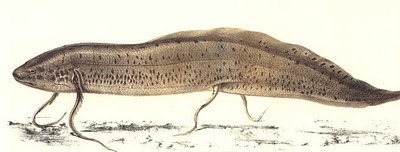 African lungfish
African lungfishAfter reading an interesting cryptozoology post on the CFZ Bloggo re the buru, which mentioned my theory that this remarkable Asian mystery beast may be a giant lungfish, here is my full coverage of this subject, excerpted from my book Extraordinary Animals Revisited (2007) after it had debuted in my book's original edition Extraordinary Animals Worldwide (1991). (Incidentally, I had originally posted this particular article on ShukerNature back on 31 January 2009, but in attempting to update it yesterday, it somehow was republished in its entirety here, thereby obliterating the earlier version.)
Known scientifically as dipnoans (‘double noses’) because they have external and internal nostrils, lungfishes are undoubtedly among the most unusual of all modern-day fishes, with an air-bladder modified into lungs (either single or paired) richly supplied with blood, paired fleshy fins, an odd but characteristic pointed tail, and an overall appearance reminiscent of some strange hybrid of eel and overgrown newt. Little wonder, then, that they so greatly perturbed zoologists when first discovered.
Although lungfishes have an extensive fossil history, only six modern-day species are known, which exhibit a curiously dispersed distribution. The first species to be brought to scientific notice was the tiny-finned, eel-like garamuru or South American lungfish Lepidosiren paradoxa, when in 1837 Dr Johann Natterer captured two specimens — one in a swamp on the Amazon’s left bank, and the other in a pool near Borba, on an Amazon tributary called the Madeira.
Next to be discovered were the four Protopterus species from Africa - P. aethiopicus, P. amphibius, P. annectens, and P. dolloi — slim-bodied with thin lengthy fins. And in 1870 the most primitive modern-day species was formally described from Queensland — Neoceratodus forsteri, the Australian lungfish. Much more robust than the others, with surprisingly sturdy, limb-like fins, and only a single lung (each of the other living lungfish species has a pair), Neoceratodus is considered sufficiently distinct to warrant its own taxonomic family; moreover, its teeth are so similar to those of the archaic fossil genus Ceratodus that it is thought of as a ‘living fossil’.
These, then, are the known present-day lungfishes — which, seemingly for no good reason, lack any type of Asian representative. Or do they? In fact, it is possible that until quite recently there was an extra species, much larger than the others, inhabiting certain swamplands in the Assam region of the Outer Himalayas.
In 1948, news correspondent Ralph Izzard of the London Daily Mail accompanied explorer Charles Stonor on a unique expedition to an eastern Himalayan swamp valley called Rilo, close to Assam’s Dafla Hills. The object of their expedition was to seek a mysterious creature called the buru, of which Stonor had learned during two trips made at the close of World War II with anthropologist J.P. Mills to another valley, to the north-east of these hills, called Apa Tani. According to the Apa Tani natives, the buru had been exterminated here when their ancestors had drained the valley’s swamplands. In contrast, the Rilo natives maintained that it still existed in their valley’s swamps.
Sadly, however, Stonor and Izzard failed to find any evidence for this assertion. Nevertheless, their searches were not wholly in vain. During the Apa Tani expeditions, Mills had meticulously recorded the detailed, quite matter-of-fact descriptions of the buru recounted by the Apa Tanis, which were based upon accounts passed down from their forefathers; and to those were added the largely comparable Rilo versions collected by Stonor and Izzard during their Rilo search. All of this information was carefully documented by Izzard in his subsequent book The Hunt For the Buru (1951), and the following is a summary of this animal’s description.
The buru was elongate, and roughly 11.5-13.5 ft in length - which included a 20-in head with a greatly extended, flat-tipped snout, behind which were its eyes. Its teeth were flattened, except for a single pair of larger, pointed teeth in both the upper and lower jaws, and its tongue was said to be forked. Its neck was about 3 ft long, and capable of being extruded or retracted. Its body was roundish, as was its tail, which tapered towards the tip, measured about 5 ft, and bore broad lobes running along the entire length of its upper and lower edges. The appearance of the buru’s limbs is somewhat uncertain: some of the natives attested that they were well-formed, roughly 20 in long, with claws; others asserted that they were nothing more than paired, lateral flanges, so that the animal seemed rather snake-like. Its skin was dark blue with white blotches and a wide white band down its body’s underside, and resembled that of a scaleless fish in texture.
As for the buru’s lifestyle, it was reputedly wholly aquatic, rarely venturing on to land even for a short time, but sometimes extending its neck above the water surface to utter a loud, bellowing sound. It did not eat fish. Lastly, but of particular interest, the Rilo natives said that when the swamps dried up during the dry season, the buru remained in the layers of mud and sludge on the swamp bottom.
Izzard believed that the buru might have been a modern-day species of dinosaur. Since his book, few writers have mentioned this mystery beast, and its identity remains very much a matter of controversy. In The Leviathans (revised 1976), the late Tim Dinsdale, the world-renowned Loch Ness monster authority, postulated from its description that it could have been some form of crocodile. Cryptozoologist Dr Roy P. Mackal, though, in Searching For Hidden Animals (1980), favoured a large species of water-dwelling monitor lizard. The riddle of the buru has intrigued me for a long time, and, after having given the matter some considerable thought, in this present book’s original incarnation, Extraordinary Animals Worldwide (1991), I offered a third contender - a giant lungfish. As I revealed, this identity provides a compelling correspondence relative to the buru’s general appearance and behaviour.
 African Lungfish
African Lungfish One of the most awkward characteristics to explain when attempting to reconcile the buru with a large reptilian species is its tendency to remain ensconced within the swamp-bottom mud when the waters dry up during the dry season. Certainly it seems unlikely that either crocodiles or monitors would (or could) stay submerged in this manner for extended periods of time. In contrast, it is well known that Lepidosiren and two Protopterus species burrow into the mud when their streams dry out during the hot summer months, and remain duly encased, in a resting state called aestivation, until the water returns. Indeed, the first specimen of P. annectens brought to Europe from its native Gambia, in 1837, was transported here whilst still entombed within its cocoon of mud and secreted slime. If the buru is (or was) a lungfish, comparable behaviour could explain its otherwise anomalous actions during the dry season.
The buru’s head was said to terminate in a great snout, flattened at the tip. This is a fair description of the head of Lepidosiren and Protopterus, whose eyes, moreover, are closely aligned behind the snout - another buru characteristic. The teeth of lungfishes consist of rows that yield connected ridges borne on thickened, fan-shaped plates, flattened in form and thus comparing closely with the flattened teeth described for the buru. In some species, smaller tooth-plates occur that are less flattened and separate - these could explain the pointed pairs of teeth reported for the buru.
Lungfishes do not have long necks. However, a modern-day species with the eel-like body of Protopterus or (especially) Lepidosiren but with pectoral fins positioned further back on its body (thus paralleling the condition present in some extinct lungfish species) could appear to the untrained observer to have a long ‘neck’, as described for the buru. The buru’s round body and tapering tail are features exhibited by modern-day lungfishes, and the lobes of the buru’s tail could be explained as merely a slight elaboration of the normal tail-fin possessed by all living lungfishes (a characteristically primitive, pointed type referred to as being protocercal). Furthermore, the tail-fin of Protopterus is indeed split dorsally into slight flukes.
As for the buru’s limbs, the lungfish identity can provide a close correspondence whether they were true limbs with clawed feet (according to some native reports), or merely paired lateral flanges that made the animal seem snake-like (according to certain other native reports). On the one hand, Australia’s Neoceratodus has sturdy flipper-like pelvic and pectoral fins, with rough spiny edges that do resemble claws. And on the other hand, the fins of Protopterus and Lepidosiren are indeed little more than paired lateral flanges with no real resemblance to limbs, thereby enhancing these fishes’ anguinine appearance - to the extent that they could seem quite serpentine to a casual observer.
In actual fact, it is even possible that the buru had both types of limb (which would resolve the controversy regarding their shape). Like so many fish species, it might have been sexually dimorphic (i.e. possessing morphologically dissimilar sexes), with the limbs of one sex (probably the male) of more robust construction than those of the other.
The buru’s skin allegedly resembled that of a scaleless fish; closely conforming once again, the scales of Protopterus and Lepidosiren are concealed under a soft outer skin, so that they appear superficially scaleless. Also, whereas Lepidosiren and Neoceratodus are mostly brown in colour, Protopterus is pale pinkish-brown with dark blue-black blotches, so that it would not require too drastic a change in colour scheme to produce the buru’s bluish-brown shade and white blotches. Moreover, it is interesting to note that Africa’s Latimeria chalumnae, that celebrated lobe-finned fish known as the coelacanth – one of only two known survivors of an ancient piscean lineage (the other is the recently discovered Indonesian coelacanth L. menadoensis) and classed by some as the lungfishes’ closest living relative - is steely-blue in colour and dappled with numerous white blotches, only fading to a dull brown following its death.
The buru was alleged to be emphatically aquatic, rarely venturing onto land and never spending any length of time there. However, the natives stated that sometimes it had been seen raising its head up out of the water and making a bellowing noise. This scenario is one that has strong lungfish associations for me.
One of the most popular exhibits of the ichthyological practicals during my days as a zoology student at university was a living specimen of an African lungfish Protopterus, which was sometimes placed on display in order that we could observe its behaviour. As it happened, for much of the time there was actually very little that we could observe, because it would spend most of the practical resting motionless at the bottom of its tank. Every so often, however, and usually when everyone’s attention was diverted elsewhere, it would solemnly perform its pièce de resistance. All at once, without any prior warning, it would raise the front part of its large body upwards, until its head just touched the surface of the water. Sometimes it would then simply nudge the tip of its snout above the water surface, but if we were lucky (by now, everyone would have rushed up to its tank to watch its celebrated performance) it would actually raise its entire head, after which it would remain in this position for several minutes, ventilating.
 South American lungfish
South American lungfish Although lungfishes have external nostrils, they breathe through their mouth, positioned at the very tip of the snout. This intake of air, readily perceived visually by the movements of its mouth and throat (proving that the lungfish is genuinely swallowing air) can also be very audible. The size of the buru was such that if it were truly a lungfish, the bellowing noise reported when its head was visible above the water might well have been the very audible result of its ventilation period.
According to native testimony, the buru was not piscivorous - in stark contrast to crocodiles and aquatic monitors. But what about lungfishes? It has been demonstrated that the diet of Protopterus depends upon its body size. Up to 1 ft long, it eats only insect larvae; between 1 and 2 ft, its diet is a mixture of insect larvae, snails, and the occasional fish; above 2 ft, it eats only snails. Among the other lungfishes, crustaceans are also popular (as is plant material with Neoceratodus). Thus a diet in which fish is only an insignificant inclusion is typical for lungfishes.
All in all, there would seem to be only one noteworthy discrepancy between the buru’s appearance and that of lungfishes - its forked tongue. This is a feature typical of monitors, certain other lizards, and snakes, but not of lungfishes. In view of the overwhelming degree of correspondence with lungfishes on other morphological grounds, however, it is quite probable that this feature was not a genuine component of the buru’s make-up, but rather a fictional flourish — especially as it is common amongst primitive tribes from many parts of the world to ascribe a forked tongue to a creature (sometimes even to another tribe’s members) that they fear or dislike.
In summary, on virtually every count a lungfish identity corresponds more than adequately with native descriptions of the buru. Overall, it seems to compare most closely with the elongate Lepidosiren or Protopterus, but its much larger size and possible Neoceratodus-like fins imply that it would have probably required a brand-new genus.
Worthy of brief mention is a second putative identity for the buru involving a strange type of freshwater fish (again previously unconsidered), a type which, although totally unrelated to lungfishes, provides some striking parallels with them, and hence with the buru. Last survivors of an ancient line, the bonytongues or osteoglossids have an oddly discontinuous distribution, existing in northern Australia, south-east Asia, West and Central Africa, and eastern South America - thus almost precisely mirroring the distribution of the lungfishes, except, of course, for Asia. Moreover, they are long, cylindrical species, the most famous being the mighty 7-ft-long arapaima or pirarucu Arapaima gigas of South America, with flattened head and snout, oddly shaped fins, and, most intriguing of all, an air-bladder modified as a lung - all features again exhibited by the lungfishes.
Most striking of all in terms of parallel lifestyles, however, is the bonytongues’ method of breathing. For most of the time they remain beneath the water surface, but every so often they raise their body upwards, and poke their mouth up through the surface to gulp air. Sounds familiar? On the other hand, unlike some lungfishes, bonytongues do not aestivate.
Nevertheless, it would require greater morphological changes to reconcile the buru with a bonytongue (even though there are already Asian forms) than with a lungfish. True, opponents of the lungfish identity might argue that the absence of any form of modern-day lungfish from Asia (though various fossil species have been found here) is a major obstacle to overcome. However, there is one final item of information that I have still to offer in favour of the lungfish identity, an item that could effectively provide this theory’s missing segment of credibility.
During my correspondence with Dr Roy Mackal regarding the buru, he informed me that he has collected excellent anecdotal reports that point to the existence in Vietnam of a 6-ft-long species of lungfish. Apart from being a zoological sensation, the discovery of such a creature would provide very considerable support for the identity of the buru as a larger, related species.
Clearly, as was shown in 1930 when the sole specimen of the enigmatic Australian paddle-nosed lungfish Ompax spatuloides was exposed as a hoax (constructed from a Neoceratodus head, mullet body, and platypus beak!), the lungfishes have a continuing potential for inciting violent controversy among scientists.
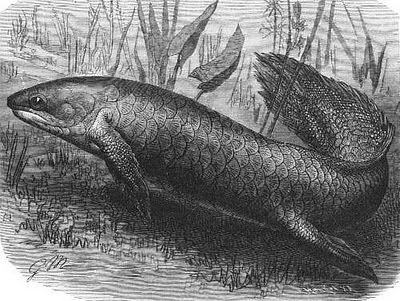 Australian lungfish
Australian lungfish
Published on August 05, 2012 14:59
August 4, 2012
THE MONGOLIAN DEATH WORM – A SHOCKING SURPRISE IN THE GOBI?
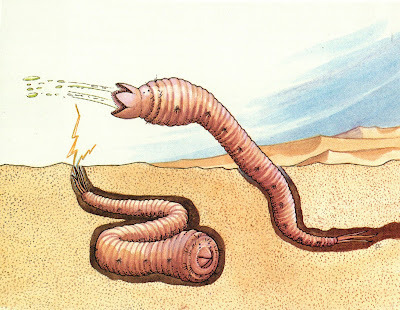 The Mongolian death worm - shocking and spraying! (Philippa Foster)
The Mongolian death worm - shocking and spraying! (Philippa Foster)It's not every day – or every expedition – that begins with a request from a country's head of government formally requesting that a specimen be captured of a creature so elusive, and deadly, that western science does not even recognise its existence. Nevertheless, that is precisely what happened in 1922 when eminent American palaeontologist Prof. Roy Chapman Andrews met the Mongolian premier in order to obtain the necessary permits for the American Museum of Natural History's Central Asiatic Expedition to search for dinosaur fossils in the Gobi Desert. And the creature that the Mongolian premier instructed him to procure? None other than the lethal allghoi khorkhoi – or, as it is nowadays commonly referred to throughout the world, the Mongolian death worm.
 Ivan Mackerle (Ivan Mackerle)
Ivan Mackerle (Ivan Mackerle)Although in the 1920s, this extraordinary mystery beast was totally unheard of outside Mongolia, today it is one of the most (in)famous of all cryptozoological creatures – thanks to the series of pioneering expeditions to its southern Gobi homeland launched by Czech explorer Ivan Mackerle, the first of which took place during June and July 1990, and which subsequently attracted considerable interest internationally. During his searches, Ivan collected a very impressive dossier of information concerning the death worm, based upon eyewitness reports and other anecdotal evidence, which he subsequently made freely available to me to use as I wished in my own writings, and which can be summarised as follows.
Its local names – allghoi khorkhoi and allergorhai horhai – translate as 'intestine worm', because according to eyewitness testimony, this mysterious sausage-shaped creature resembles a living intestine. Red in colour with darker blotches, it measures 1-1.6 m long and is as thick as a man's arm, but has no discernable scales, mouth, nor even any eyes or other recognisable sensory organs. It is said to be truncated at both ends, but according to some accounts at least one end also bears a series of long pointed structures at its tip.
 Illustration of Mongolian death worm based upon eyewitness descriptions (Ivan Mackerle)
Illustration of Mongolian death worm based upon eyewitness descriptions (Ivan Mackerle)For much of the year, the death worm remains concealed beneath the Gobi's sands, but during the two hottest months – June and July – it can sometimes be encountered lying on the surface, particularly after a downpour of rain.
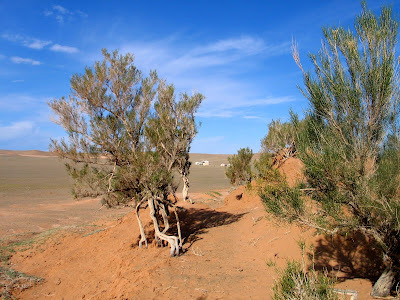 Black saxaul
Black saxaulLocals claim that it can also be found in association with the black saxaul Haloxylon ammodendron, a yellow-flowered desert shrub, whose roots are parasitized by the goyo Cynomorium songaricum – a strange, cigar-shaped plant of uncertain taxonomic affinities.
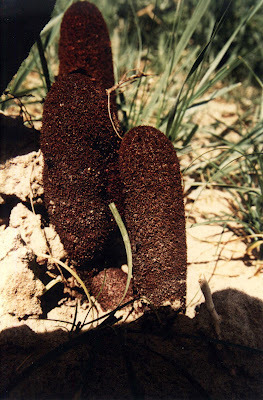 Goyo plants (Ivan Mackerle)
Goyo plants (Ivan Mackerle)According once again to local lore, the death worm is deadly for two very different reasons. If approached too closely, it is said to raise one end of its body upwards (as portrayed on the front cover of my book The Beasts That Hide From Man, 2003), and then squirt with unerring accuracy at its victim a stream of extremely poisonous, acidic fluid that burns the victim's flesh, turning it yellow, before rapidly inducing death. It is claimed that the death worm derives this highly toxic substance externally - either from the saxaul's roots or from the goyo attached to them (and thereby reminiscent of how South America's deadly arrow-poison frogs derive their skin toxins from certain small arthropods that they devour). During my own researches, however, I have uncovered no evidence to suggest that the saxaul's roots are poisonous, and I have revealed that the goyo is definitely not poisonous (it is eaten as famine food, and used widely in Chinese herbalism). So if the death worm truly emits a venomous fluid, it presumably manufactures it internally, rather than deriving it externally.
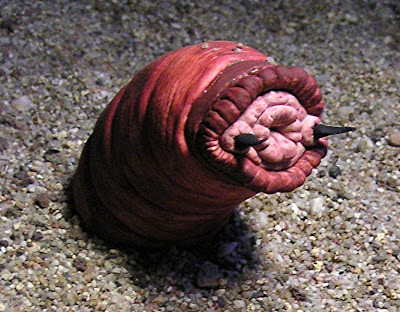 Model of Mongolian death worm emerging from sand (Markus Bühler)
Model of Mongolian death worm emerging from sand (Markus Bühler)Even more shocking – in every sense! – is the death worm's second alleged mode of attack. Nomadic herders inhabiting the southern Gobi tell of how entire herds of camels have been killed instantly merely by walking over a patch of sand concealing a death worm beneath the surface. Moreover, one of Ivan Mackerle's local guides recalled how, many years earlier, a geologist visiting the Gobi as part of a field trip was killed when he began idly poking some sand one night with an iron rod – as he did so, he abruptly dropped to the ground, dead, for apparently no reason, but when his horrified colleagues rushed up to him, they saw the sand where he had been poking the rod suddenly begin to churn violently, and from out of it emerged a huge, fat death worm.
The camels presumably died from coming into direct physical contact with the death worm hidden beneath their feet, but the geologist only touched it indirectly, via the metal rod. Consequently, the only conceivable way that this action could have caused his death is by electrocution – which would obviously explain the camels' instant deaths too. Although there are several different taxonomic groups of fish containing species that can generate electricity – including the famous electric eel and gymnotids, as well as the electric catfish, electric rays, mormyrids, rajid skates, and electric stargazers – no known species of terrestrial creature possesses this ability. So if the native claims concerning the camels and the geologist are correct, and always assuming of course that it really does exist, the death worm must be a very special animal indeed. But what precisely could it be?
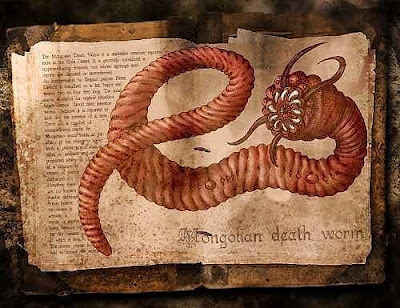 Mongolian death worm (www.static.environmentalgraffiti.com)
Mongolian death worm (www.static.environmentalgraffiti.com)Despite its English name and superficially similar external appearance, it is highly unlikely that the death worm could be a bona fide earthworm or related invertebrate. For although some earthworms do grow to prodigious lengths, and certain species known aptly as squirters even spurt streams of fluid from various body orifices, none exhibits a water-retentive cuticle, which would be imperative for survival in desert conditions to avoid drying out. Of course, there may be a highly-specialised earthworm in the Gobi that has indeed evolved such a modification, but with no precedent currently known, the chances of this seem slim. In addition, if the death worm's powers of electrocution are real, this would require even more modification and specialisation for an earthworm to fit the bill.
Caecilians constitute a taxonomic order of limbless amphibians that are deceptively worm-like in appearance and predominantly subterranean in lifestyle. Certain species can also attain a total length matching the dimensions reported for the death worm. As with true worms, however, caecilians' skin is water-permeable, so once again even a giant caecilian would soon dry out in the arid Gobi, unless, uniquely among these particular amphibians, it had evolved a water-retentive skin.
 19th-Century engraving of a caecilian, Siphonops
19th-Century engraving of a caecilian, SiphonopsIf the death worm is genuine, it is almost certainly some form of reptile. To my mind, the likeliest solution is an unusually large species of amphisbaenian. On account of their vermiform appearance (most species are limbless), these little-known reptiles are also called worm-lizards, even though, taxonomically speaking, they are neither. As with caecilians, they spend much of their lives underground, rarely coming to the surface except after a heavy fall of rain. This all corresponds well with the death worm's reported behaviour. Furthermore, unlike real worms and caecilians the skin of amphisbaenians is water-retentive, so a giant species would not dry out in the Gobi.
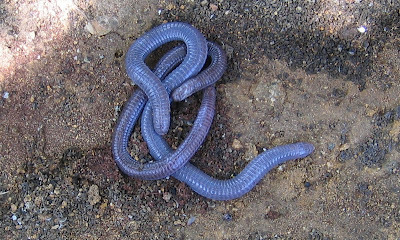 Two Iberian amphisbaenians Blanus cinereus (Richard Avery/Wikipedia)
Two Iberian amphisbaenians Blanus cinereus (Richard Avery/Wikipedia)Conversely, whereas the death worm is said to be smooth externally, amphisbaenians are very visibly scaly, and they also have a readily-observed mouth. In addition, they are all completely harmless, which wholly contradicts the twin death-dealing talents attributed to the Gobi's moat greatly-feared denizen. Naturally, it is conceivable that these abilities are entirely apocryphal, nothing more substantial than superstitious fancy. After all, several known species of amphisbaenian, and also caecilian, are fervently believed by their local human neighbours to be deadly poisonous even though in reality they are wholly innocuous.
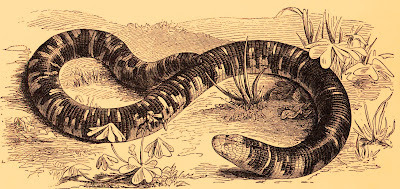 19th-Century engraving of an amphisbaenian
19th-Century engraving of an amphisbaenianMuch of what has been proposed for and against an amphisbaenian identity for the Mongolian death worm applies equally to the possibility of its being an unknown species of very large legless true lizard - akin perhaps to the familiar slow worm and glass snake, or even to the skinks, some species of which are limbless. However, these lizards are much less worm-like and subterranean than amphisbaenians, so overall the latter provide a more satisfactory match with the death worm.
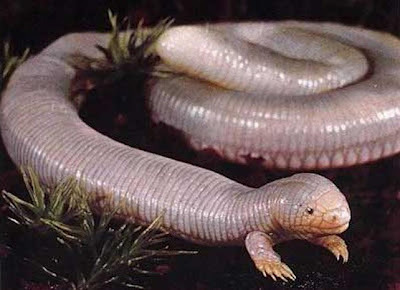 Mexican ajolote - possessing a pair of extremely small forelegs, this is the only type of amphisbaenian with any limbs at all (picture source unknown to me)
Mexican ajolote - possessing a pair of extremely small forelegs, this is the only type of amphisbaenian with any limbs at all (picture source unknown to me)Last, but by no means least, is the thought-provoking prospect that the death worm may be a highly specialised species of snake. Not only do most of the above-noted physical and behavioural similarities between the death worm and the amphisbaenians and legless lizards apply here too, but spitting cobras also offer a famous precedent for an elongate creature that can eject a stream of corrosive venom with deadly accuracy at a potential aggressor. Moreover, the spine-bearing tip described for the death worm recalls a genus of cobra-related species known as death adders Acanthophis spp., which possess a spiny worm-like projection at the tip of their tail that acts as a lure for potential prey.
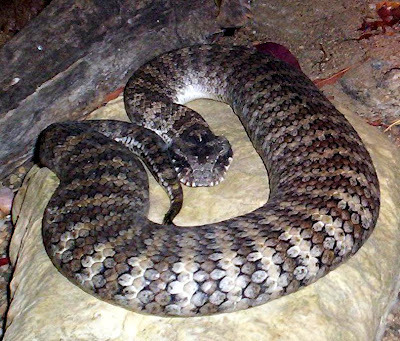 Death adder
Death adderTheir name recognises the fact that although, like cobras, they are elapids, the death adders have evolved to occupy the ecological role filled elsewhere by true vipers. Could there be a specialised, unknown species of death adder that has evolved the venom-spitting ability of its spitting cobra relatives? If so, this would vindicate the locals' testimony concerning the death worm's emissions. But what about its alleged powers of electrocution?
Remarkably, this too may be more than just a myth. For if the death worm were indeed a snake and perhaps sported such smooth, fine, tiny scales that they were not readily discernable, when it was crawling through sand these scales may be able to generate a weak electrical current via friction – a process known as triboelectricity, which has already been documented from certain sand-dwelling snake species. If this in turn gave rise to exaggerated descriptions of its potency, it is easy to see how, over the course of several generations of ever more fanciful retellings, the entirely false belief in a creature that kills by electrocution could ultimately arise.
 Mongolian death worm as visualised by renowned graphics artist Andy Paciorek (Andy Paciorek)
Mongolian death worm as visualised by renowned graphics artist Andy Paciorek (Andy Paciorek)So could it be that in spite of the death worm's initially unlikely form and behavioural proclivities, there actually could be a real, scientifically-undescribed species at the heart of this longstanding mystery, albeit one far less flamboyant and formidable than the version described in local testimony? Or is the entire death worm scenario nothing more than native folklore?
Science-fiction devotees reading about the Mongolian death worm will undoubtedly recall Frank Herbert’s celebrated series of 'Dune' novels. These were set on a desert planet called Arrakis – home to an enormous species of vibration-sensitive sand worm called the shai-hulud, which could be ‘called’ to the surface when the planet’s human inhabitants used a vibration-engendering device known as a thumper.
 The shai-hulud or giant sand worm of Arrakis in Frank Herbert's 'Dune' novels (picture source unknown to me)
The shai-hulud or giant sand worm of Arrakis in Frank Herbert's 'Dune' novels (picture source unknown to me)In a classic scenario of transforming science-fiction into science fact, and directly inspired by the 'Dune' stories, during his first Gobi expedition Mackerle and his team tested out their very own specially-constructed thumper, but to no effect. During their second Gobi expedition, clearly favouring a more emphatic approach this time, they set off a number of controlled explosions in areas said by the locals to harbour subterranean death worms, in the hope that the massive vibrations elicited by these explosions would stimulate the worms to surface. Sadly, however, their summoning again went unheeded, as no worms appeared.
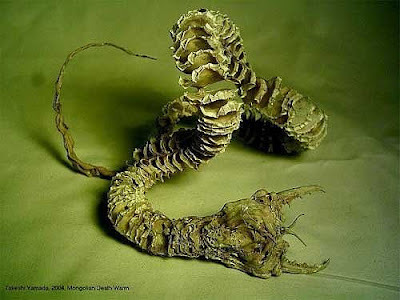 Model of the Mongolian death worm (Takeshi Yamada)
Model of the Mongolian death worm (Takeshi Yamada)Moreover, in recent times several expeditions other than those of Ivan Mackerle have also searched the southern Gobi's vast terrain in search of its purported 'monster', but once again none has met with any success so far.
These include an expedition led by English cryptozoological field researcher Adam Davies in 2003, a team sent out by the Centre for Fortean Zoology in 2005, and more recently a two-man expedition led by New Zealand journalist David Farrier in August 2009. Unfortunately, none succeeded even in seeing, let alone capturing, a death worm (a local man informed the CFZ team that on one occasion a killed specimen had been taken away by Russian zoologists, but he did not provide any names or details that could be pursued). Nevertheless, some informative anecdotal evidence has been gathered, and both the Adam Davies-led team and the CFZ team observed and photographed a carving of a supposed death worm (although it sported eyes) on exhibition at the remote Gobi Museum.
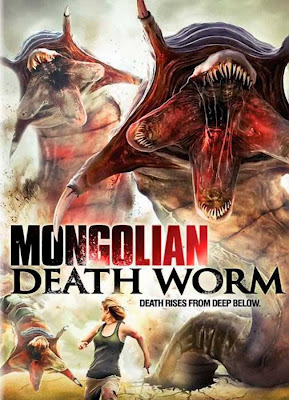 'Mongolian Death Worm' - an action-packed made-for-television sci-fi film from 2010, in which the heroes battle gigantic specimens far bigger than anything reported in real life by the Gobi nomads (Syfy)
'Mongolian Death Worm' - an action-packed made-for-television sci-fi film from 2010, in which the heroes battle gigantic specimens far bigger than anything reported in real life by the Gobi nomads (Syfy)Most telling of all, however, as some of these later expeditions were startled to discover, the newest generation of Gobi nomads are as likely to be riding desert motorbikes as camels, and some even carry mobile phones inside the folds of their traditional desert robes. So perhaps they are also heeding less and less the traditional stories and beliefs of their elders.
 'Tremors' - one of my all-time favourite monster movies, this is a wonderfully tongue-in-cheek sci-fi film from 1990 featuring gigantic desert-concealed worms in the USA
'Tremors' - one of my all-time favourite monster movies, this is a wonderfully tongue-in-cheek sci-fi film from 1990 featuring gigantic desert-concealed worms in the USAHaving said that, there may be another, very different reason why these expeditions have returned empty-handed. Some locals claim that death worms have been seen far less frequently in recent years than in the past. Who knows - perhaps, just as the rest of the world has finally started to learn about and become interested in it, the Mongolian death worm has begun slipping inexorably into extinction.
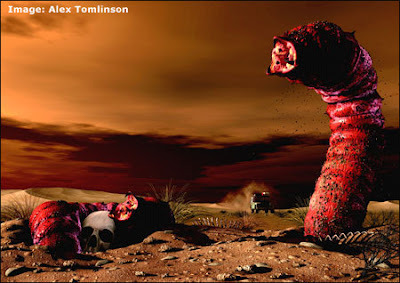 Mongolian death worm (Alex Tomlinson)
Mongolian death worm (Alex Tomlinson)How ironic that would be – almost as ironic, in fact, as Prof. Roy Chapman Andrews's straight-faced promise to the Mongolian premier back in 1922 that if his expedition did indeed encounter a death worm during their search for dinosaur fossils in the Gobi, they would do their best to secure its capture using a pair of long steel collecting forceps. In view of what reputedly happened to the hapless geologist who poked one of these fearful creatures with a metal rod, it's probably just as well that Prof. Andrews and his team never did find any!
For the most detailed, comprehensive coverage of the Mongolian death worm ever published, see my book The Beasts That Hide From Man (Paraview: New York, 2003).
 The Beasts That Hide From Man, featuring one of Ivan Mackerle's Mongolian death worm illustrations on its front cover (Dr Karl Shuker)
The Beasts That Hide From Man, featuring one of Ivan Mackerle's Mongolian death worm illustrations on its front cover (Dr Karl Shuker)
Published on August 04, 2012 14:50
August 3, 2012
THE TRUTH ABOUT BRAZIL'S AMAZING 'PENIS SNAKE' - NOT A SNAKE, AND CERTAINLY NOT A...
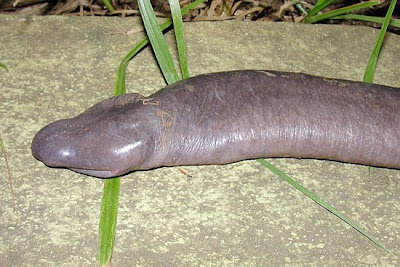 One of the recently-captured specimens of Atretochoana eiselti (Matt Roper)
One of the recently-captured specimens of Atretochoana eiselti (Matt Roper)During the past 24 hours, the world media has been full of stories concerning the supposed discovery in Brazil of a 'new species' of 'blind snake' that 'resembles a human penis'. As is so often the case with media reports describing unusual, little-known animals, however, the truth is very different - as I shall now reveal in an attempt to set the facts straight regarding this beast once and for all.
In reality, although it is indisputably a most amazing and very distinctive form it is not a new species, it is not a snake, and its claimed afore-mentioned resemblance is very much in the eye of the beholder – or, to put it another way (so to speak!): if the relevant portion of my body looked like this creature, I'd be seriously worried!
Vermiform, eyeless, grey in colour, and each measuring approximately 3 ft long, six specimens of the aquatic species in question were found at the bottom of the Madeira River during the draining of a portion of it by engineers in November 2011 for a new hydroelectricity dam in the northern Brazilian state of Rondonia. According to biologist Juliano Taban who works for the company constructing the dam, all six were captured for initial observation. Sadly, however, one of them died, but three of the others were released back into the river shortly afterwards, with the remaining two being retained for further scientific study and formal taxonomic identification, news regarding which was only made public this week. So what exactly did these sizeable but very peculiar creatures turn out to be?
In fact, they belonged to a species of limbless amphibian known as a caecilian - but no ordinary one. On the contrary, this particular caecilian constituted one of the most extraordinary herpetological discoveries of the 20th Century when officially described and named back in 1968. In my recent book The Encyclopaedia of New and Rediscovered Animals (Coachwhip: Landisville, 2012), I documented this highly significant yet scarcely-known species' uniquely surprising history as follows:
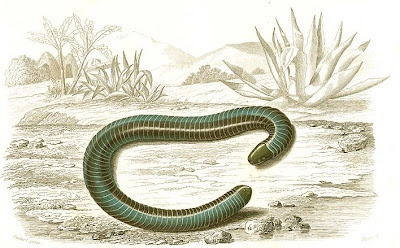 A 19th-Century colour engraving of a caecilian, Siphonops
A 19th-Century colour engraving of a caecilian, Siphonops"Caecilians [constitute] a taxonomic order of entirely limbless species, many of which greatly resemble earthworms. Most are predominantly subterranean, fossorial species (although there are also some aquatic river-dwelling forms), and are rarely seen above-ground unless flushed out during rainfall. They inhabit wet tropical localities in Africa, Asia, and South America, feed principally upon insects and worms, and most are relatively small, but a few extra-large species also exist, growing up to 4 ft long and superficially similar in outward appearance to snakes.
"One feature that all species share is a pair of lungs – or at least they did until 1968, or, to be exact, 1995; as will be seen, the history of the following ground-breaking species is nothing if not complicated. It began in 1968, when a notably large preserved specimen of caecilian originating from an unspecified location in South America became the type (and for a long time thereafter the only) specimen of a new species, which was formally christened Typhlonectes eiselti by Kansas University herpetologist Dr Edward H. Taylor in a major monograph entitled The Caecilians of the World.
"Measuring 27.5 in long, this new species’ unique specimen was an adult female housed in the collections of Vienna’s Naturhistoriches Museum, but Taylor’s official description of it had been unusually brief, and concentrated primarily upon its external morphology. Not until the early 1990s did it attract any further scientific attention, even though it was on full public display inside a glass exhibition case at the museum during the intervening years. When it was finally re-examined, however, by zoologist Dr Ronald A. Nussbaum from Michigan University and Bristol University caecilian specialist Dr Mark Wilkinson, they closely investigated its internal form, which duly revealed a very remarkable and hitherto-unsuspected surprise – this large, enigmatic, but previously neglected caecilian was lungless.
"Indeed, their discovery meant that T. eiselti was now the largest species of lungless tetrapod known to science, and was sufficiently removed from all other caecilians to require them to publish a major redescription of it, which appeared in 1995. Moreover, in their paper, they also created a new genus for it, renaming this radically disparate species Atretochoana eiselti, which highlighted the fact that even its choanae (internal nostrils) were sealed. It also totally lacked any pulmonary blood vessels. Clearly, therefore, this caecilian respired entirely through its skin (cutaneous respiration is also carried out by other caecilians, but only as a supplement to normal pulmonary respiration). Its cranium exhibited fundamental differences from that of other caecilians too. If only there were other examples of this extraordinary species to examine, but where to look? The provenance within South America of its one and only specimen was unknown.
"Happily, in 1998, after 30 long years, a second specimen was finally recorded – documented by Wilkinson and three co-researchers – which was confirmed to have originated from a river in Brazil, but its precise location was unknown. Measuring 31.7 in (80.5 cm), it was longer than the first one but otherwise very similar in form. And that is where the remarkable history of A. eiselti comes to an end, at least for now, as no further specimens have been discovered.
"What has been discovered, meanwhile, is a second species of lungless caecilian, and whereas A. eiselti is aquatic, this new one is land-based. Found in the scrub of Guyana’s Iwokrama Forest and described online in late 2009 (in hard-copy format in 2010), when it was formally named Caecilita iwokramae, it is the only member of a new genus and is much smaller than A. eiselti, its holotype only measuring 4.4 in long."
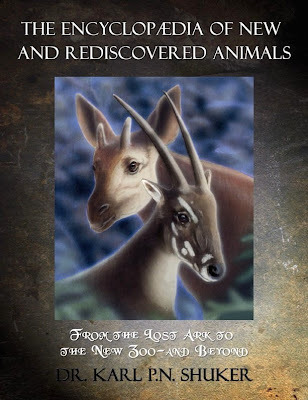 My book containing the above account concerning A. eiselti (Dr Karl Shuker)
My book containing the above account concerning A. eiselti (Dr Karl Shuker)Thanks to those engineers' discovery at the bottom of the Madeira River last November, however, A. eiselti has now been formally rediscovered and is no longer such an enigma. Yet, inevitably, its zoologically-imposing twin status as both the world's biggest species of caecilian and the world's largest species of lungless tetrapod have been entirely overshadowed by the media's obsession with promoting phallic comparisons relating to it. As a result, this once-obscure species can now boast a number of newly-coined common names worthy of screenwriter Talbot Rothwell – double-entrendre maestro for Britain's famous and much-loved series of 'Carry-On' comedy films - at his most inspired, ranging from floppy snake to man-aconda!
Amusing though these may be, I sincerely hope that in the future the media will treat this rediscovered marvel rather more seriously, and accord it the scientific respect that it so richly deserves after having languished so long in virtual anonymity. So, to quote 'Carry On' veteran Kenneth Williams's most famous catch-phrase: "Stop messing about!"
 Some of the recently-captured specimens of Atretochoana eiselti (Juliano Taban/Divulgação)
Some of the recently-captured specimens of Atretochoana eiselti (Juliano Taban/Divulgação)
Published on August 03, 2012 15:43
August 2, 2012
WASHINGTON’S EAGLE AND OTHER GIANT MYSTERY EAGLES OF NORTH AMERICA
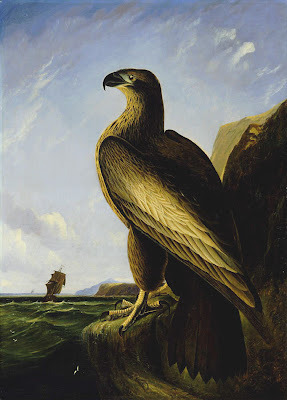 Washington's eagle (John James Audubon)
Washington's eagle (John James Audubon)Even though celebrated American naturalist-artist John James Audubon (1785-1851) produced some of the most spectacular paintings of North American wildlife ever created, he has also stirred up a degree of controversy among ornithologists, because his artwork includes depictions of certain birds that cannot be identified with any species known to present-day science. Most of these feathered mysteries are small, relatively nondescript perching birds, but there is one big (indeed, very big) exception – Washington’s eagle.
Today, science recognises the existence of just two species of eagle in the USA – the bald eagle Haliaeetus leucocephalus (a sea eagle), and the golden eagle Aquila chrysaetos (a true eagle). According to Audubon and a number of contemporary writers, however, there was – and may still be? – a third, much larger, visibly distinct species, referred to variously as the great eagle, great sea eagle, bird of Washington, Washington eagle, and Washington’s eagle. Said to possess an enormous 3.1-m wingspan, it hardly seems the kind of bird that could be readily overlooked or forgotten, and yet it is nowadays conspicuous only by its absence from present-day bird books. So whatever happened to Washington’s eagle, and could this cryptic bird be of especial relevance to cryptozoology?
 John James Audubon, painted in 1826 (John Syme)
John James Audubon, painted in 1826 (John Syme)It was Audubon who first brought this majestic but mystifying raptor to widespread attention, after he and his Canadian fur-dealer companion aboard a trading vessel on the Upper Mississippi observed one such bird flying overhead on a cold February day in 1814. His companion informed him that it was a rare bird called the great eagle, which he had previously seen only in the Great Lakes region, and after viewing it attentively Audubon was convinced that it was a species new to science, native to America’s northern realms.
During the next few years, Audubon made four other sightings, which included observing at close range on some cliffs bordering Kentucky’s Green River a pair at their nest with two young – but to his great disappointment he missed the opportunity to shoot any of them. (This was, of course, the pre-conservation era of the 1800s, when Audubon’s overriding desire was to obtain a specimen in order to paint it for his increasingly impressive folio of North American bird illustrations.) Then, just two years after spying the nesting birds, came his fateful encounter close to the village of Henderson, Kentucky, with an adult individual scavenging at a pig slaughter. Audubon had a gun with him, took careful aim, and duly bagged his long sought-after specimen of the noble Washington’s eagle.
After parcelling up its corpse, Audubon ran with it excitedly to the nearby home of his friend, experienced hunter Dr Adam Rankin, who, after examining it, claimed never to have seen such a bird before, even though he had lived in the area for many years. Both men studied the corpse in depth, which proved to be that of a male specimen. Furthermore, while it was still freshly-killed, Audubon penned the following extensive morphological description of this remarkable eagle:
"The male bird weighs 14 ½ avoirdupois [pounds], measures 3 ft. 7 in. in length, and 10 ft. 2 in. in extent. The upper mandible dark bluish black. It is, however, the same colour for half its length, turning into yellow towards the mouth, which is surrounded with a thick yellow skin. Mouth blue; tongue the same; cere greenish-yellow; eye large, of a fine chestnut colour, iris black, the whole protected above by a broad, strong, bony, cartilaginous substance, giving the eye the appearance of being much sunk. Lores lightish blue, with much strong recumbent hair; upper part of the head, neck, back, scapulars, rump, tail coverts, femorals, and tail feathers, dark coppery glossy brown; throat, front of the neck, breast, and belly, rich bright cinnamon colour; the feathers of the whole of which are long, narrow, sharp-pointed, of a hairy texture, each dashed along the center with the brown of the back; the wings, when closed, reach within an inch and a half of the tail feathers, which are very broad next to the body. Lesser coverts rusty iron grey, forming with that colour and elongated oval, reaching from the shoulders to the lower end of the secondaries, gradually changing to the brown of the back as it meets the scapulars. The secondaries of the last middle tint. Primaries brown, darkest in their inner veins, very broad and firm; the outer one 2 ½ in. shorter than the second, the longest 24 in. to its root, about a half an inch in diameter at the barrel. The under wing coverts iron grey, very broad, and forming the same cavity that is apparent in all of this genus with the scapulars, which are also very broad. Legs and feet strong and muscular: the former one and a half inches in diameter; the latter measuring, from the base of the hind claw to that of the middle toe, 6 ½ in. Claws strong, much hooked, the hind one 2 in. long, the inner rather less, all blue black and glossy. Toes warty, with rasp-like advancing hard particles, covered with large scales appearing again on the front of the leg, all of dirty strong yellow. Leg feathers brown cinnamon, pointed backwards."
He then utilised this specimen as the subject of a magnificent, meticulously-executed, life-sized painting depicting its species, which he formally dubbed Falco [now Haliaeetus] washingtonii, the bird of Washington or Washington’s eagle, in honour of America’s first president, George Washington.
 Washington's eagle without background (John James Audubon)
Washington's eagle without background (John James Audubon)According to Audubon’s account and painting, Washington’s eagle resembled in superficial outward appearance an immature bald eagle (i.e. predominantly brown in colour, lacking its species’ characteristic white head and tail until it has attained maturity). However, it exhibited certain very distinct differences from the latter.
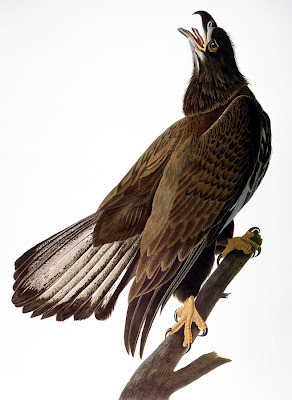 All-brown, immature bald eagle (John James Audubon)
All-brown, immature bald eagle (John James Audubon)Washington’s eagle’s cere (a soft, fleshy swelling on the beak’s upper basal region, containing the nares or nostrils) did not correspond in appearance with any known version reported from the bald eagle. The uniform scutellation (scaling) on Washington’s eagle’s tarsi is not seen in any developmental stage of the bald eagle. And Washington’s eagle’s size was bigger – far bigger – than that of any specimen of bald eagle ever documented. Audubon claimed that his specimen measured 3 ft 7 in (109 cm) long, and sported a wingspan of 10 ft 2 in (3.1 m), which significantly exceeds the measurements of any known species of North American raptor, including the golden eagle.
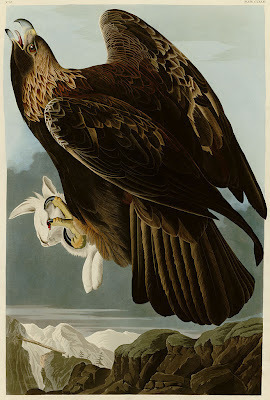 Golden eagle (John James Audubon)
Golden eagle (John James Audubon)Faced with these distinctions, the ornithological world initially accepted Washington’s eagle as a valid species, including it in several authoritative publications. Moreover, several other notable persons (respected Boston naturalist Dr Lemuel Hayward and ornithologist Thomas Nuttall among them) reported their own Washington’s eagle sightings and those of additional eyewitnesses too. Hayward actually captured one such eagle, but after keeping it alive for a considerable time he supposedly killed his hapless prisoner with mercury in order to send its body to what he referred to at that time as the ‘Linnaeum Museum’ (presumably the museum of London’s Linnaean Society?); according to another report, the museum did receive the bird’s body, then later auctioned it off, but its subsequent fate is unknown.
Eyewitnesses even stated that the flight and feeding behaviour of Washington’s eagle differed from those of the bald eagle. Thus, when hunting, Washington’s eagle allegedly flew in wider circles than the bald eagle, and whereas the latter swoops down directly after spotting prey, Washington’s eagle would descend in spirals before finally diving. Also, although the bald eagle is often seen stealing fish from another native piscivorous bird of prey, the osprey, Washington’s eagle was never reported indulging in this kleptoparasitic practice. And whereas the bald eagle usually builds its massive nests in trees, Washington’s eagle built ground nests on rocky cliffs near water, even in wooded localities.
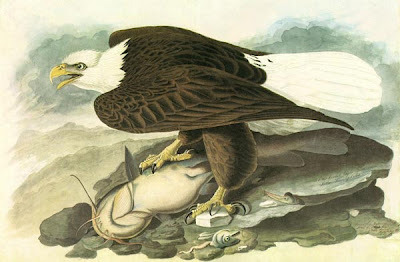 Adult bald eagle (John James Audubon)
Adult bald eagle (John James Audubon)Nevertheless, even before Audubon’s death in 1851, the first shadows of doubt had begun to be cast upon the authenticity of his great sea eagle. In particular, claims were aired that the morphological differences specified by him for it were contentious, and that his measurements were in error. Ultimately, Washington’s eagle became totally discredited, at best synonymised with the bald eagle’s northern subspecies and at worst dismissed as a mythical species or even a deliberate hoax perpetrated by Audubon. But is this attitude justified?
Worth noting here is that a few museum specimens (such as Hayward’s above-mentioned ‘Linnaeum Museum’ example, one at the New England Museum, one at the Cleveland Academy of Science, and one at Boston’s Museum of Natural History) have been claimed, but none of them, not even Audubon’s own specimen, seems still to survive, or at least be traceable. A specimen was also reputedly housed at Philadelphia’s Peales Museum, but this was presumably destroyed when the museum later burnt down. Even so, if we assume that Washington’s eagle did indeed exist at one time, three mutually-exclusive options seem to be on offer with regard to its zoological identity.
1) It may be based upon nothing more than normal but misidentified immature bald eagles and/or golden eagles.
2) It may involve some exceptionally (or even abnormally) large immature bald eagles and/or golden eagles.
3) It may truly represent a species distinct from all those currently accepted by science.
In his excellent blog Biofort, wildlife author-teacher Scott Maruna of Jacksonville, Illinois, has republished online his very comprehensive review of the Washington’s eagle saga (previously published by him as a paper in two American ornithological journals, Meadowlark and The Ohio Cardinal), in which he meticulously examines the pros and cons for considering Washington’s eagle to be a genuine species in its own right. These can be summarised as follows.
Beginning with its uniform tarsal scutellation: one critic boldly stated that Audubon’s painting was inaccurate and mistakenly claimed that Audubon’s description had been written years after his painting had been prepared, and must therefore have been based upon his own inaccurate depiction. In reality, of course, Audubon’s description was penned shortly after the eagle had been killed, and hence well before his painting had been prepared. Another critic opined that the uniform scutellation in Audubon’s painting was merely an optical illusion created by the angle at which the bird had been portrayed. Again, however, this argument is dismissed by Audubon’s substantiating written description. In addition, the greenish-yellow colour of Washington’s eagle’s cere does not match the bright primrose-yellow colour of the bald eagle’s; nor does its long thin shape as painted by Audubon correspond with the squat cere of the latter species.
As for Audubon being mistaken about the bird’s size: when creating his spectacular, painstakingly-detailed life-size paintings of birds, Audubon used a complex double grid system to guarantee precision of dimensions, with one grid placed directly behind the mount and an identical one for his folio, thereby corresponding the respective shape and size of subject and image exactly. So unless he deliberately misrepresented his Washington’s eagle’s dimensions (and there seems no good reason why he would do this, as this would inevitably compromise the scientific worth of all of his other bird paintings), we must assume that its mighty size was genuine.
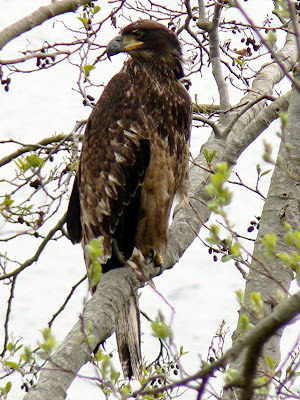 Immature bald eagle (Walter Siegmund/Wikipedia)
Immature bald eagle (Walter Siegmund/Wikipedia)One of the most popular explanations on offer is that Audubon simply did not recognise that his and all other Washington’s eagles were merely immature bald eagles and/or golden eagles. Yet Audubon’s diaries clearly differentiate between the various eagle types, consistently referring to all-brown immature bald eagles as ‘brown eagles’, and Washington’s eagles as ‘s. eagles’ (sea eagles). The latter designation shows that Audubon also readily differentiated Washington’s eagle from the golden eagle (which is a species of true eagle, whose extended leg feathers instantly distinguish it from sea eagles – a characteristic with which Audubon would certainly have been acquainted, because he had painted the golden eagle).
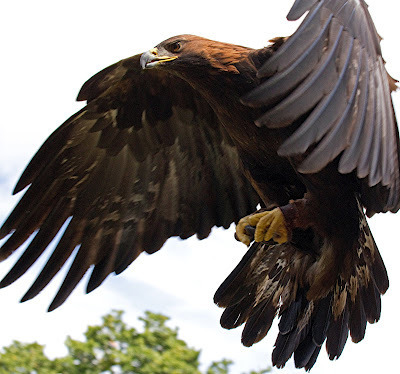 Golden eagle (Tony Hisgett from Birmingham, UK/Wikipedia)
Golden eagle (Tony Hisgett from Birmingham, UK/Wikipedia)Moreover, Audubon was very familiar with all-brown immature bald eagles, which he had seen on countless occasions (and again also painted), and was fully aware that they mature into the well-known white-headed adult form (unlike some of his contemporaries, who had mistakenly deemed the all-brown immature form and the white-headed adult to represent two separate species). He even remarked in one diary that the sea eagles (Washington’s) that he had seen were roughly one quarter larger than the brown eagles (immature bald eagles). This is significant because, intriguingly, all-brown immature bald eagles can be very slightly rangier than their white-headed adult counterpart due to marginally greater contour wing feather length. So for him to note how much larger than immature bald eagles was Washington’s eagle only emphasises its great size. By comparison, adult bald eagles are 70-102 cm long (Audubon’s specimen of Washington’s eagle was 109 cm long), and boast a wingspan of up to 2.44 m (Audubon’s eagle’s wingspan was 3.1 m). (Even adult golden eagles, moreover, are only up to 1 m long, with an average wingspan of just over 2 m.)
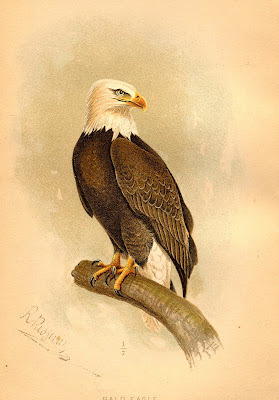 Adult bald eagle, 19th-Century painting
Adult bald eagle, 19th-Century paintingIn addition, female bald eagles are roughly 25 per cent larger than males, thus making the size of Audubon’s eagle even more noteworthy. For although it was huge in bald eagle terms (regardless of sex), it was, according to Audubon, a male – which, if true, suggests that female Washington’s eagles would be quite enormous!
A related aspect that discounts an immature bald eagle as a likely candidate for Washington’s eagle is the fact that Audubon (in the company of others) witnessed a nesting pair of the latter birds with two young. Very occasionally, a bald eagle will breed while still sporting immature all-brown plumage. However, for two such plumage-perplexed oddities to meet, mate, and rear young together is so unlikely as to be unworthy of serious consideration – especially when such freaks would of course need to be not only aberrantly-plumaged but also exceptionally large, thereby compounding the implausibility of this proposal. As for the hunting and flying idiosyncrasies of Washington’s eagle, witnessed by observers other than just Audubon, these offer yet another challenge to any bald eagle-related identification.
So could it really be that Washington’s eagle was indeed a valid, giant species of eagle, native to northern North America? Even if this were true, it was already so rare in Audubon’s time that it must surely have died out soon afterwards – otherwise it would still be reported today. And with the handful of alleged preserved specimens all lost or of presently unknown location and therefore unavailable for scrutiny via modern-day taxonomic analytical techniques, there seems no way now in which this riddle can ever be conclusively resolved – unless, that is, Washington’s eagle is, in fact, still alive and still being reported today.
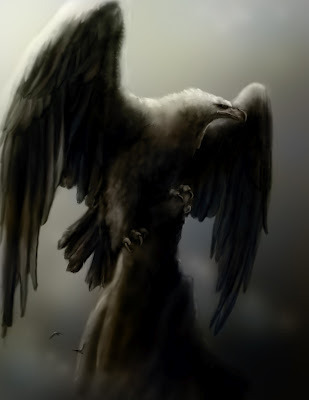 Giant eagle (Gymnogene/deviantART.com)
Giant eagle (Gymnogene/deviantART.com)If we turn to the annals of cryptozoology, modern-day reports in North America of huge eagles (as distinct from other reports of giant vulturine or condor-like birds, with naked heads and ring-necks) have indeed been filed. Scott Maruna noted in a sequel to his Washington’s eagle paper that surviving Washington’s eagles may conceivably be the source of such reports originating in particular from Pennsylvania’s Black Forest region – Washington’s eagle having been documented a century earlier from the Great Lakes area north of Pennsylvania. And in the remote coastal areas of northern and western Alaska, containing localities rarely if ever visited by humans, even such a sizeable bird form as this could persist, undisturbed and unseen, for generations. Could it even be that the legendary Amerindian thunderbird originated at least in part from doubtlessly awe-inspiring sightings of Washington’s eagles?
Needless to say, of course, this is all highly speculative (especially with no apparent palaeontological support for such a bird). And yet...every so often, a report comes along that makes me wonder, what if?
One such report was placed online by Maruna, and recounted a sighting of a huge raptor one winter’s morning in 2004 by William McManus and his wife, spied across a small meadow between their cabin home (located roughly 24 km north of Stillwater, Minnesota) and a river channel, as it perched in a dead tree. They immediately discounted any bald eagle, adult or immature, and also a golden eagle, on account of the sighted bird’s dark brick-red colour, and also because of its size, which they estimated to be well over 3 ft (1 m) tall. After viewing it for some 2 hours at a distance of only 60 m or so, they moved nearer but the bird flew away, revealing itself to be indeed an eagle (and not a condor, as they had begun to wonder), with an eagle’s head and neck, and an enormous wingspan far exceeding a bald eagle’s. After seeing Audubon’s painting of his Washington’s eagle in Maruna’s blog, McManus believed that this is what he and his wife saw that day.
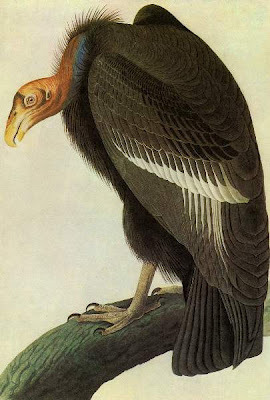 California condor Gymnogyps californianus, North America's only native species of modern-day condor (John James Audubon)
California condor Gymnogyps californianus, North America's only native species of modern-day condor (John James Audubon)This communication received two interesting responses posted in Maruna’s blog. One, posted by Kurt N on 24 October 2006, stated that he had seen at the Hawk Mountain bird observatory in Pennsylvania a photo taken there in or around 1993 that depicted a large unidentified eagle that was clearly no bald or golden eagle but had elicited speculation that it was some kind of sea eagle. And in a post of 9 January 2007 (later removed), a reader with the username of dogu4 mentioned that a couple of years earlier (2005), a bush pilot and some passengers flying over a remote stretch of western Alaska claimed to have seen a gigantic bird.
As dogu4 also noted pertinently:
"If there were ever an area where it [Washington’s eagle] could have survived as a small population un-noticed, the coastal areas out along the edges of the Y-K Delta would fit the description as far as inaccessibility and remoteness, not to mention the abundance of sea-life, rookeries and breeding grounds for a multitude of relatively un-disturbed populations of birds and sea-mammals. And the incredible solitude."
An equally thought-provoking report reached me in November 2009, courtesy of a longstanding correspondent called Mark, from Birmingham, Alabama, who emailed me with news of an intriguing report aired a month or so earlier on an episode of the popular North American late-night radio talk show entitled ‘Coast To Coast AM’, presented by George Noory. Apparently, on two separate occasions during the course of this particular episode, which focused upon cryptozoology, a man aged in his 40s called in, claiming a remarkable sighting made by him and two ex-army friends while in a harbour around the Aleutian Islands off western Alaska.
The caller stated that while standing not far away from some telegraph poles, they saw that perched on top of one of them was what he referred to as a gigantic bald eagle. He mentioned that there were other, normal-sized bald eagles flying around it and that it was therefore very easy to estimate its size – 10 ft (3 m) or so tall. This seems far too large, but perhaps the caller was thinking of wingspan rather than height? In any event, he told host Noory that he and his two friends looked at each other in amazement, hardly believing what they were seeing. Referring to it as a gigantic bald eagle implies that it had a white head. Yet, as already discussed here, only adult bald eagles have this, but immature, all-brown bald eagles are just as big and eyecatching, so we cannot say for sure that the Alaskan mega-eagle was white-headed simply because it was likened to a bald eagle. What we can say, however, is that if it was all-brown, it would bear much more than a passing resemblance to that most enigmatic of northern USA mystery birds, Washington’s eagle.
So if any eagle-eyed (pun intended!) reader heard this ‘Coast To Coast AM’ episode, I’d be delighted to receive any additional information concerning the above caller report that you could send in.
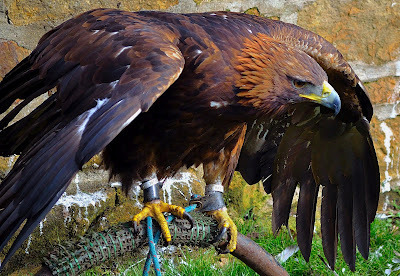 Could there really be a type of eagle even bigger than the golden eagle but unrecognised by science living in North America?
Could there really be a type of eagle even bigger than the golden eagle but unrecognised by science living in North America?Most recently of all, beginning on 17 March 2011 with one that was forwarded by Fortean Times to me, I received a series of detailed emails from Mike E. Richburg of West Columbia in South Carolina, USA, in which he described what he believes to have been a truly enormous eagle that he spied approximately 20 years earlier in his home state near the Combahee River. A letter from Mike (using the pseudonym Mike Richards) in which he reported his sighting was subsequently published in FT (June 2011).
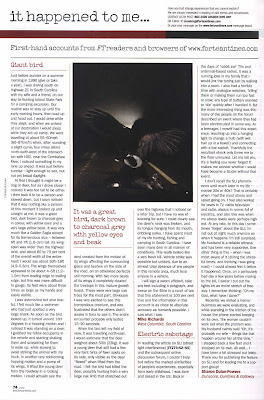 Mike's letter as published in Fortean Times #276 (June 2011)
Mike's letter as published in Fortean Times #276 (June 2011)But now, combining all of the much more comprehensive accounts contained in his various emails to me and presented here as a ShukerNature world-exclusive (with his kind permission for me to do so and fully credited to him under his real name), this is Mike's full description of what he saw:
"I witnessed a very, very large bird (6-7 ft. tall) that looked almost exactly like a Golden Eagle except for its extraordinary size. The avian flew off with a small deer in its grasp. Its wingspan was wider than one lane of US HWY 21. It lifted the deer from the roadway and cleared the treetops with three cycles of its wings.
"The deer's neck was clearly visibly broken, and not just a little bit. It had clearly very recently happened. I have spent much of my life outdoors, hunting, fishing, hiking, camping, etc, and have seen deer in all manner of states and speak from a position of knowledge on the deer itself. I am also quite clear on the size and age of the deer, and stand firmly by my 50 lb estimate. Also not included was what first caught my eye, the movement of spooked (alerted) deer far ahead in the roadway. I saw the flashes of white on their hind ends as they bounded briefly about in the roadway, in an obvious attempt to get the heck out of there, apparently as afraid of this thing as I was. I am sure there are many more small details that may or may not be important.
"Also, one thing that really stuck out to me about the whole thing is when the bird looked up. It didn't look at my vehicle. It looked straight at me. In my face. We made eye contact, which totally freaked me out, and convinced me that the creature was very intelligent. This has always stuck out as being very impressive to me. It looked straight into my eyes. Still kinda creeps me out.
"In addition, I will inform you that I think about what I saw almost daily, and frequently dream about it. I often wake up when the animal looks at me. I still feel afraid of it. I was so afraid at the time of the sighting, it is hard to explain. Let's just say I knew a human would be no match for this thing.
"I could actually see the wind created by the flapping motion of the bird's wings affect the vegetation (bushes, grass, etc) on the side of the road. This was most noticeable on the second cycle of the wings, which was the first "full cycle" while still low over the roadway. This effect was very similar to the "wave" of air created by a passing truck that can be seen in tall grass on the roadside. Also of note was the great ease in which the bird took flight with the deer in tow. Much like a Hawk with a mouse, or an Eagle with a 3 lb rabbit. It looked very easy for the bird, and I am sure it was not the first time he flew away with very large prey.
"I have extensively researched both the Haast's Eagle [Harpagornis moorei, the giant eagle of New Zealand that officially died out in c.1400 AD] and Washington's Sea Eagle, both thought to be extinct. I believe what I saw was similar to both in appearance with some differences worth noting. The bird I saw clearly had a yellowish beak, most depictions of Washington's Eagle report a dark beak. The overall coloration however, was not that dissimilar. The underbelly coloration was similar to Haast's eagle, but appeared to be a different pattern. The overall size of the bird I saw was also even larger than either of these great birds. The bird I saw was very, very Eagle like, as I previously stated, looking almost exactly like a Golden but much larger. Its feathers were also a little more "ruffled" or out of place, for the most part, except for the head itself where the feathers clung closely and neatly, giving a "smooth' appearance. This greatly contrasted with the "rough" look of the rest of the bird, which started at the neck.
"The bird I saw also had very impressive legs. The top of the leg was very large and apparently muscular. Comparable to a great dane with feathers. The lower legs looked very much like tree trunks, and were very noticeably stout. The feet themselves were also very impressive and noticeable, not as yellow as I would have thought, more like dirty dishwater grey and had the look of leather that was excessively cracked and peeled. There ain't no lizard in the bird I saw. It was 100% Eagle, and could have lifted prey much larger.
"As I have stated in the summary attachment, it was in the roadway directly in front of me at close range. I had a very good look at it."
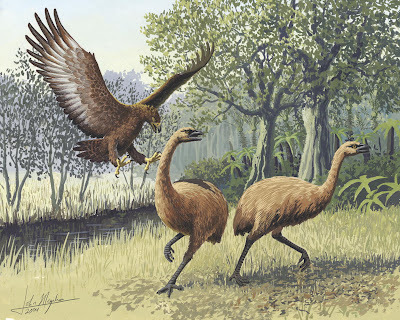 Haast's eagle attacking giant moas (John Megahan/PLoS Biology/Wikipedia)
Haast's eagle attacking giant moas (John Megahan/PLoS Biology/Wikipedia)Here is Mike's summary attachment, which I received from him on 18 April 2011:
"I wanted to thank you again for your interest in my encounter with a giant eagle type bird in SC in about 1990. Although I am not much of an artist, I took a shot at drawing what I saw that morning, and have enclosed the illustration with this correspondence. Albeit crude and somewhat primitive, it provides a visual aide. If the average picture is worth a thousand words, then this one ought to be worth a million. This is how the animal looked when it raised its head and looked at me, at which time I finally realized what I was looking at. The bird flared out his wings slightly and gave me a very intimidating glare, as if to say that the deer was his and he was ready to defend it. It was a very fierce and menacing look. Of particular interest was the very robust, stout girth of the body and the very wide stance. His right leg was on the deer’s neck and the left on the hind end. His eyes also seemed very large, even for such a large animal. The bird also had very noticeably large feet. I did not notice the great length of the beak until he turned. Here is a brief list of observable physical attributes.
"Size of animal:
"6-7 ft from highest part of wings to roadway as pictured. Please note that highest part of wings was tilted toward vehicle, and wingtips pointed away from vehicle and noticeably laying on road, as were the tail feathers. Exact height of animal if upright is unknown.
"Width of wingspan was undeterminable until bird turned around and took flight, was then estimated at least 16 ft, and probably around 18 ft. Broadness of each wing estimated at least 4-5 ft from leading edge to trailing edge.
"Very wide girth and very wide stance. Distance between legs at least 2.5-3 ft.
"Very large feet with large visible talons.
"Color of animal:
"Overall color was dark brown to charcoal gray.
"The underside of the wings appeared lighter in color with white “spots” that were actually not round, but square-ish and rectangular and “L” shaped.
"The underside of the tail which the bird presented to me after turning around was also much lighter in color as it got closer to the bird. Tips of tail feathers were dark on underside as well as the top.
"Yellow beak.
"Yellow to gold eyes.
"Grayish looking feet with black talons."
 Mike's drawing of the bird that he saw (Mike E. Richburg)
Mike's drawing of the bird that he saw (Mike E. Richburg)In a subsequent email, sent to me on 3 May 2012, Mike included two further descriptive accounts, both of which offered some important additional insights into the appearance and nature of the giant eagle that he had encountered:
"I awoke from a dream this morning with the proverbial light bulb over my head. I have now realized why the bird's feet looked like they did. In a word, it was mud. To fully understand why I am so sure, one must appreciate the geography of the area. This is a flat almost featureless coastal plain, except for the Carolina Bays (a unique unexplained phenomenon in their own right), that was once the sea floor. Fresh water is in abundance, but everywhere there is water, and in a lot of places there is not, there is also a very greasy black to charcoal gray mud. This is the only kind of mud around and there is plenty of it. This mud, of course, dries to a lighter shade of gray. The bird had to drink fresh water, and to do that I am 100% sure he would have had to stand in that kind [of] mud, or fly at least 50 miles. I am now very confident what I saw was half dried mud that was flaking off, thus explaining the coloration and extreme texture on the bird's feet.
"Several years after the sighting I confided in a friend and told him what I had seen. The conversation turned to the pattern under the wings and my curiosity about it. I insisted that it must be for camouflage purposes, to help conceal the large animal. In my attempt to describe the pattern I took some white spray paint to a piece of plywood I had. One thing lead to another, and with the help of some other colors, I had quickly made a rough imitation of the pattern over the whole side of the 4’ x 8’ sheet of plywood. A debate about the effectiveness of the camo ensued immediately.
"To settle the debate we tried a very unscientific study, by placing the plywood in different surroundings, and stepping back to take a look. It did not work against a clear sky, nor around a stand of Pine trees and a few other places. To make a long story short it sucked in everyplace we put it except for one. When we placed the wood up in an Oak tree behind my house it became virtually undetected. There were other hard wood trees around, behind and in front of the wood. There were Persimmon, Gum, Sparkleberry, Maple etc. It became astonishingly clear that the white “blocks” closely imitated the small “bits” of sky one can see when looking up thorough the trees.
"I had hoped to conduct the same experiment again just to send you pics, but I was much younger then and the chances of me climbing 30’ up in a tree with a 4’ x 8’ sheet of plywood are slim to none, and I think I just saw Slim leaving town.
"Conclusions: The camouflage system is very area specific and only works well in growths of deciduous trees, where it excels in the extreme. Noteworthy is the fact that this is also where the bird was seen. This pattern works very well half way up a mature 50’-70’ tree, where the bird might likely hunt from at times. The pattern was so effective that a deer, much less the average person, would never detect the presence of the great bird unless the bird moved or made noise, even with its wings open and just above its prey. In fact, if the bird was on a large branch next to the trunk of the tree, much like a large Owl might sit, it would be virtually invisible even with the wings fully opened, as long as it was facing towards its prey. I believe the bird would in fact hunt this way due to its many advantages. Humans hunt deer from tree stands in similar fashion to gain these same advantages. The predator's scent is not at ground level, better vision, etc. It would only make sense that this creature would use these advantages as well."
The combined accounts from Mike quoted here constitute the most extensive eyewitness description of an unidentified giant eagle in North America that I have ever read, added to which is his hand-drawn illustration. Although not identical, this mysterious mega-eagle certainly recalls the equally mystifying Washington's eagle, and makes me wonder anew as to whether such a form was not only truly distinct from all other North American species of eagle but still survives on this continent today, albeit assuredly in very small numbers, yet very effectively camouflaged, thus preserving the secrecy of its existence from all but a scant few, highly fortunate observers.
Alternatively, is it conceivable that the individual birds documented in this ShukerNature post, including the specimen upon which Audubon established his Washington's eagle species, in reality constitute freak, over-sized specimens of the golden eagle, possibly exhibiting genetically-induced gigantism?
Of particular interest is Mike's statement that the eagle carried off a small deer whose weight was estimated by him to be approximately 50 lb (22.7 kg). Adult male golden eagles living in the wild weigh around 3.6 kg (7.9 lb) on average, and adult females living in the wild weigh around 5.1 kg (11 lb) on average, though females weighing up to 6.8 kg (15 lb) have been confirmed. Golden eagles are normally able to lift and carry off prey roughly half their own weight – which would be around 1.8 kg (4 lb) for an adult male, and 2.6 kg (5.5 lb) for an adult female, though prey victims up to 4 kg (8.8 lb) in weight have been recorded. Yet even this is far short of the 22.7 kg (30 lb) weight claimed by Mike for the deer abducted by the giant eagle seen by him. So either Mike over-estimated the deer's weight, or there are some phenomenally powerful - as well as gargantuan - eagles out there, which could conceivably weigh around 11.4 kg (15 lb), i.e. twice that of the largest formally recorded golden eagles.
Whatever the explanation for such birds may be, the fact remains that eagles much bigger than science believes they have any right to be may indeed exist in the USA – such birds could even have inspired the age-old Native American legends of thunderbirds, as documented in my book In Search of Prehistoric Survivors (1995) - and that in itself is something well worth investigating further.
FURTHER READING
Scott Maruna, “Substantiating Audubon’s Washington Eagle”, biofort.blogspot.com, posted 14 Oct 2006.
Scott Maruna, “Of Washington Eagles, Ivory-bills and ‘Thunderbird’ Sightings”, biofort.blogspot.com, posted 18 Oct 2006.
Scott Maruna, “Witness Claims a Washington Eagle Sighting”, biofort.blogspot.com, posted 23 Oct 2006.
'Mike Richards' [=Mike E. Richburg], "Giant Bird", Fortean Times, #276, p. 74 (June 2011).
C.W. Webber, Wild Scenes and Song-Birds (Leavitt & Allen: New York, 1858).
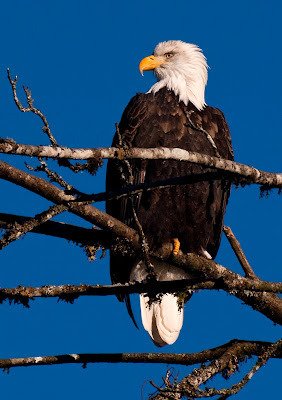 Adult bald eagle (Eric Frommer/Wikipedia)
Adult bald eagle (Eric Frommer/Wikipedia)
Published on August 02, 2012 13:30
August 1, 2012
MERMAID BODY FOUND? IN SEARCH OF FOLK WITH FINS
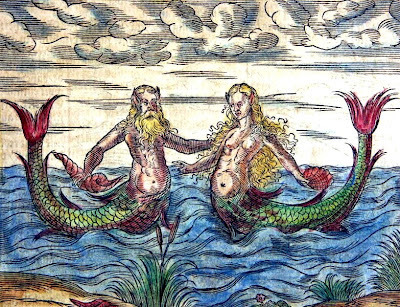 Medieval bestiary engraving of merman and mermaid
Medieval bestiary engraving of merman and mermaidSince the very earliest times, stories of merfolk or merbeings - sea-dwelling entities with the upper bodies of humans and the tails of fishes - have been reported by maritime travellers. Such accounts have been traditionally dismissed as nothing more than quaint folklore, and in some cases this is unquestionably true. Various others are simple misidentifications of seals or sirenians (manatees and dugongs.
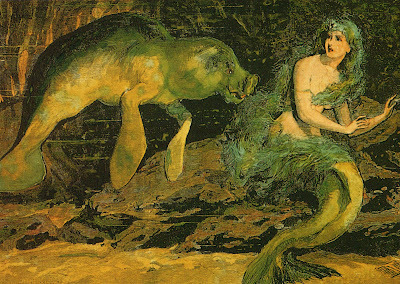 Semi-humorous 19th-Century engraving of a manatee and a mermaid
Semi-humorous 19th-Century engraving of a manatee and a mermaidEqually, most accounts of preserved mermaid specimens are based upon skilfully prepared hoaxes, usually featuring the head and body of a monkey deftly attached to the tail of a large fish - not so much folk with fins as fakes with fins. These extraordinary entities are typifed by American circus impresario Phineas T. Barnum's infamous 'Feejee Mermaid', exhibited by him at Broadway'sConcert Hall on 1842:
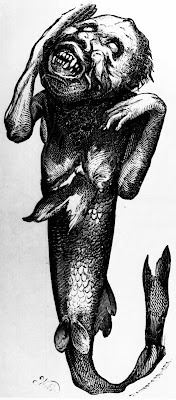 Engraving of Barnum's 'Feejee Mermaid'
Engraving of Barnum's 'Feejee Mermaid'as well as by the excellent, highly impressive modern-day faux mermaid prepared specially for me by expert movie model-maker Alan Friswell - thanks Al!
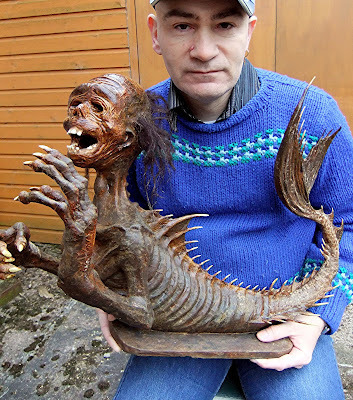 My very own genuine fake mermaid! (Dr Karl Shuker)
My very own genuine fake mermaid! (Dr Karl Shuker)However, there are also certain other cases on record that cannot be readily discounted as either folktales or frauds, as demonstrated by the following highly intriguing selection of thought-provoking, still-unresolved examples.
SWALLOWED BY A SHARK
If merfolk exist, then they must surely fall prey at times to some of the seas' greatest predators - the sharks. One little-known case on file not only supports such a possibility but may also provide an insight into merfolk morphology. The creature in question was discovered inside the stomach of a shark caught on the northwest coast of Iceland, and was closely observed by the priest of Ottrardale. His description was quoted in a 19th-Century book by Sabine Baring-Gould called Iceland, Its Scenes and Sagas, and reads as follows:
"The lower part of the animal was entirely eaten away, whilst the upper part, from the epigastric and hypogastric region, was in some places partially eaten, in others completely devoured. The sternum, or breast-bone, was perfect. This animal appeared to be about the size of a boy eight or nine years old, and its head was formed like that of a man. The anterior surface of the occiput was very protuberant, and the nape of the neck had a considerable indentation or sinking. The alae [lobes] of the ears were very large, and extended a good way back. It had front teeth, which were long and pointed, as were also the larger teeth. The eyes were lustreless, and resembled those of a codfish. It had on its head long black, coarse hair, very similar to the fucus filiformis [filamentous seaweed]; this hair hung over the shoulders. Its forehead was large and round. The skin above the eyelids was much wrinkled, scanty, and of a bright olive colour, which was indeed the hue of the whole body. The chin was cloven, the shoulders were high, and the neck uncommonly short. The arms were of their natural size, and each hand had a thumb and four fingers covered with flesh. Its breast was formed exactly like that of a man, and there was also to be seen something like nipples; the back was also like that of a man. It had very cartilaginous ribs; and in parts where the skin had been rubbed off, a black, coarse flesh was perceptible, very similar to that of the seal. This animal, after having been exposed about a week on the shore, was again thrown into the sea."
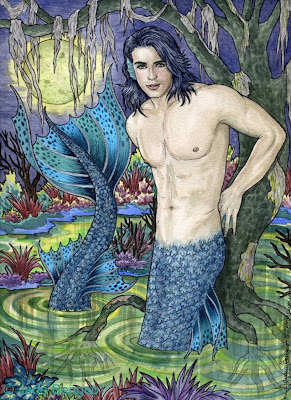 'Swamp Dweller' merman painting (Jade Gengko)
'Swamp Dweller' merman painting (Jade Gengko)THE MERMONKEY OF YELL
During the 1800s, six fishermen acquainted with naturalist Dr Robert Hamilton were fishing off the island of Yell, one of the Shetland Islands north of Scotland, when they captured a decidedly monkey-like mermaid, which had become entangled in their lines:
"The animal was about three feet long, the upper part of the body resembling the human, with protuberant mammae, like a woman; the face, the forehead, and neck were short, and resembling those of a monkey; the arms, which were small, were kept folded across the breast; the fingers were distinct, not webbed; a few stiff, long bristles were on the top of the head, extending down to the shoulders, and these it could erect and depress at pleasure, something like a crest. The inferior part of the body was like a fish. The skin was smooth, and of a grey colour. It offered no resistance, nor attempted to bite, but uttered a low, plaintive sound. The crew, six in number, took it within their boat; but superstition getting the better of curiosity, they carefully disentangled it from the lines and from a hook which had accidentally fastened in its body, and returned it to its native element. It instantly dived, descending in a perpendicular direction."
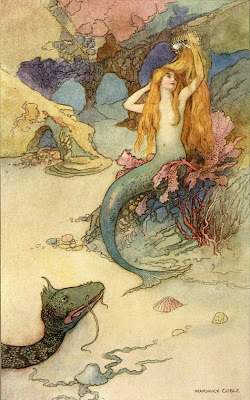 Mermaid painting (Warwick Goble)
Mermaid painting (Warwick Goble)SOME LITTLE-PUBLICISED MERFOLK REPORTS
The following reports have previously received little if any mainstream attention, so I am especially indebted to American cryptozoological author Michael Newton for passing them on to me.
The first of these was published by the Daily Kennebec Journal newspaper of Augusta, Maine, on 24 June 1873. The most pertinent section reads as follows:
"About the same time [c.1737] a story came from Virgo, in Spain, to the effect that some fishermen on that coast had caught a sort of a merman, five feet and a half from head to foot. The head was like that of a goat, with a long beard and moustache, a black skin, somewhat hairy, a very long neck, short arms, hands longer than they ought to be in proportion, and long fingers, with nails like claws; webbed toes, and a fin at the lower part of the back."
Interestingly, an engraving of a weird goat-headed merbeing, variously dubbed a sea-Pan, sea-satyr, or sea-devil, based upon a skeleton and some mummified exhibits, appeared in the second edition of Conrad Gesner’s Historiae Animalium Liber IV. Qui est de Piscium et Aquatilium Animantium Natura (1604). Allegedly, it had been fatally wounded by stones thrown at it by some sailors who had witnessed it throwing itself out of the Illyrian Sea onto the shore in an attempt to capture a small child there. This must surely have been another cleverly-constructed fraud.
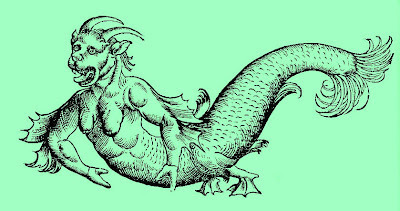 Gesner’s goat-headed merbeing
Gesner’s goat-headed merbeingContinuing the Daily Kennebec Journal article:
"The magazines for 1775 gave an account of a mermaid which was captured in the Levant and brought to London. One of the learned periodicals gravely told its readers that the mermaid had the complexion and features of a European, like those of a young woman; that the eyes were light blue, the nose small and elegantly formed, the mouth small, the lips thin, "but the edges round like those of a codfish; that the teeth were small, regular and white; that the neck was well rounded, and that the ears were like those of an eel, but placed like those on the human specie [sic], with gills for respiration, which appear like cork." There was no hair on the head, but "rolls...” There was a fin rising pyramidally from the temples, "forming a foretop, like that of a lady's headdress." ["]The bust was nearly like that of a young damsel, a proper orthodox mermaiden, but, alas! all below the waste was exactly like a fish! Three sets of fins below the waist, one above the other, enabled her to swim. Finally it is said to have an enchanting voice, which it never exerts except before a storm." The writer in the Annual Register probably did not see this mermaid, which the Gentleman's Magazine described as being only three feet high. It was afterward proved to be a cheat, made from the skull of the angle [angel] shark.
"A Welsh farmer, named Reynolds, living at Pen-y-hold in 1782, saw a something which he appears to have believed to be a mermaid; he told the story to Dr. George Phillips, who told it to Mrs. Moore, who told it to a young lady pupil of hers, who wrote out an account of it to Mrs. Morgan, who inserted it in her "Tour to Milford Haven." How much...[it] gained on its travels - like the Three Black Crows or the parlor game of Russian Scandal - we are left to find out for ourselves; but its ultimate form was nearly as follows: One morning, just outside the cliff, Reynolds saw what seemed to him to be a person bathing in the sea, with the upper part of the body out of the water. On nearer view, it looked like the upper part of a person in a tub, a youth, say of sixteen or eighteen years of age, with nice white skin!, a sort of brownish body, and a tail was under the water. The head and body were human in form, but the arms and hands thick in proportion to length, while the nose, seeming up high between the eyes, terminated rather sharply. The mysterious being looked attentively at Reynolds, and at the cliffs, and at the birds flying in the air, with a wild gaze, but uttered no...[sound]. Reynolds went to bring some companions to see the merman or mermaid, but when he returned it had disappeared. If we like to suppose that Reynolds had seen some kind of seal, and that the narration had grown to something else by repeating freely mouth to mouth, perhaps we shall not be very far wrong."
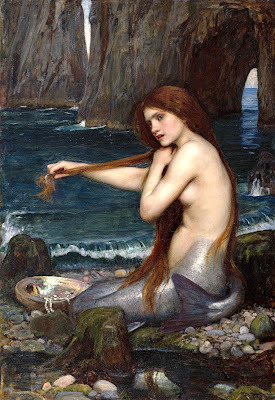 Mermaid painting by John Waterhouse
Mermaid painting by John WaterhouseAlso of interest is the following report, published by the Cape Brooklyn Eagle newspaper on 22 August 1886:
"The fishermen of Gabarus, Cape Breton [an island off the coast of Nova Scotia, Canada], have been excited over the appearances of a mermaid, seen in the waters by some fishermen a few days ago. While Mr. Bagnall, accompanied by several fishermen, was out in a boat, they observed floating on the surface of the water a few yards from the boat what they supposed to be a corpse. Approaching it for the purpose of taking it ashore, they observed it to move, when to their great surprise, it turned around in a sitting position and looked at them and disappeared. A few moments after[,] it appeared on the surface and again looked toward them, after which it disappeared altogether. The face, head, shoulders and arms resembled those of a human being, but the lower extremities had the appearance of a fish. The back of its head was covered with long, dark hair resembling a horse's mane. The arms were shaped like a human being's, except that the fingers of one hand were very long. The color of the skin was not unlike that of a human being. There is no doubt, that the mysterious stranger is what is known as a mermaid, and the first one ever seen in Cape Breton waters."
Were it not for the mention of fingers, I would be inclined to identify this particularly hirsute merbeing as a seal, quite probably a fur seal. Could it be that there is an unknown species of seal with a foreshortened muzzle, rendering its face superficially humanoid, and with flippers in which the digits are more prominently revealed than in other seals? Such a species would correspond closely with a number of noteworthy merbeing reports.
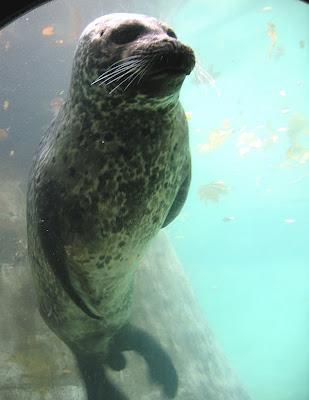 Seal in upright mermaid posture (L. Heafner)
Seal in upright mermaid posture (L. Heafner)Finally: On 3 November 1896, the Cape Brooklyn Eagle published another noteworthy merbeing report:
"Seattle, Wash., November 3 - A party of Englishmen who have been porpoise fishing in the Pacific discovered and killed a monster that resembled a merman. The party was off the island of Watmoff on the hunting boat and Lord Devonshire, one of the fishers, had just shot a porpoise, when some one called out, "Look there!" pointing to a frightful looking monster about a cable's length away. Hastily raising his weapon his lordship fired and hit the creature between the eyes. The shot, though it did not kill it, so stunned the animal that it lay perfectly still on the surface of the sea.
"It showed fight when hauled into the boat and had to be killed to prevent it from swamping the craft. The monster is said to be one of the strangest freaks ever put together. It measures 10 feet from its nose to the end of its fluke shaped tail and the girth of its human shaped body was just six feet. It would weigh close to 500 pounds. From about the breast bone to a point at the base of the stomach it looked like a man. Its arms, quite human in shape and form, are very long and covered completely with long, coarse, dark reddish hair, as is the whole body.
"It had, or did have, at one time four fingers and a thumb on each hand, almost human in shape, except that in place of finger nails there were long, slender claws. But in days probably long since gone by, it had evidently fought some monster that had got the best of it, for the forefinger of the right hand, the little finger of the left and the left thumb are missing entirely. Immediately under the right breast is a broad, ugly looking scar which looked as if sometime in the past it had been inflicted by a swordfish. The creature is now being preserved in ice at Seattle and will be shipped to the British museum."
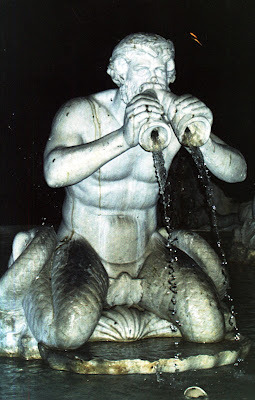 Merman (triton) sculpture in the Piazza Navona, Rome (Dr Karl Shuker)
Merman (triton) sculpture in the Piazza Navona, Rome (Dr Karl Shuker)As I feel sure that the scientific world would have heard more about this entity had it indeed reached the British Museum, I am assuming that it was never shipped there after all. In June 2008, I sent details concerning this fascinating case to Mandy Holloway in the Department of Zoology at London's Natural History Museum, who very kindly promised to pursue the matter for me through the museum’s archives – just in case! However, no trace of any merman was found. Ah well, at least we tried!
SOUTH AFRICA’S MERMAID ROCK PAINTINGS
Created for untold centuries by the San hunter-gatherer people, the rock paintings in the Karoo, South Africa, depict some remarkable entities, but none more so than certain ones bearing a striking resemblance to mermaids! Seeking to provide a rational scientific explanation for them after the discovery of some additional examples in Ezeljachtpoort (again in the Karoo) was made public during 1998, anthropologists have suggested that they either portray departed spirits (a dominant theme in San society) or represent the hallucinogenic experience of San shamans. According to one elderly San man interviewed by the paintings’ researchers, however, they depict bona fide water maidens, and even today such beings are indeed reported quite frequently in this African region.
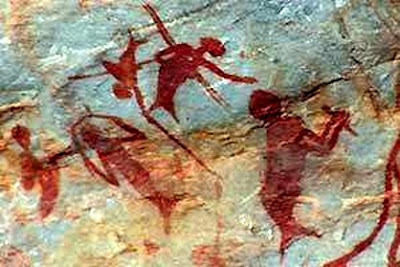 San rock-art mermaids in the Karoo (travel.iafrica.com)
San rock-art mermaids in the Karoo (travel.iafrica.com)AN UNDISCOVERED AQUATIC PRIMATE?
In July 1960, eminent British scientist Professor Sir Alister Hardy FRS published a highly thought-provoking hypothesis in New Scientist - speculating that instead of evolving from upright plains-dwelling ancestors, man learned to stand erect by having descended from aquatic ape-like forms. This startling idea has since been pursued in great detail by researcher Elaine Morgan in The Aquatic Ape (1982) and later books, and has provoked much dissension among scientists. I plan to assess this notion in detail within a future book. For now, therefore, let me just say that if it is indeed valid, it has great bearing upon the question of mermaids and their kind.
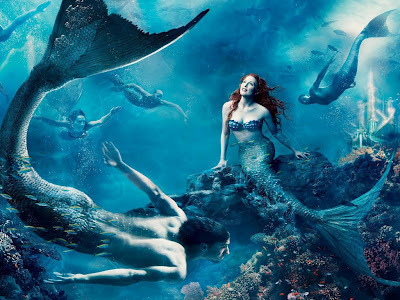 Merfolk, or aquatic apes? (picture source unknown to me)
Merfolk, or aquatic apes? (picture source unknown to me)After all, if, while some of these water-dwelling ape-like primates did indeed become terrestrial and evolve into modern-day Homo sapiens, others remained in the sea - continuing to evolve and surviving into modern times but retaining their fully aquatic form -what would they be like today? Perhaps we already know the answer - and perhaps that answer already has a name: merfolk.
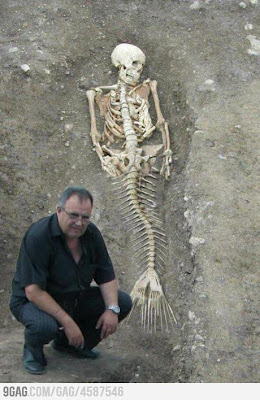 Fake but fabulous - a supposed mermaid skeleton (9gag.com)
Fake but fabulous - a supposed mermaid skeleton (9gag.com)
Published on August 01, 2012 11:13
Karl Shuker's Blog
- Karl Shuker's profile
- 45 followers
Karl Shuker isn't a Goodreads Author
(yet),
but they
do have a blog,
so here are some recent posts imported from
their feed.



